A fighter jet is defined as a fast, agile military airplane whose primary role is air-to-air combat. Fighter jets play a vital role in securing air superiority, intercepting enemy aircraft, and supporting ground forces. These formidable machines are powered by high-thrust jet engines and are frequently equipped with afterburners to achieve speeds often over Mach 2. This raw speed and agility are critical for delivering lethal payloads of missiles, rockets, and advanced gun systems to eliminate military targets while ensuring pilot survivability. Modern fighter jets blend stealth, speed, advanced avionics, multi-role capabilities, and agile air-to-air and air-to-ground combat effectiveness.

The best fighter jet in the world overall is currently the US-made Lockheed Martin F-35 Lightning II, with its state-of-the-art stealth capabilities and advanced sensor package. These features allow the F-35 to operate undetected in enemy airspace while sharing combat information within a network-centric combat environment. These tactical advantages enable F-35 pilots to kill enemy targets beyond visual range with incredible precision while keeping the jet and its pilot out of danger.
The F-35 is unmatched in its multirole utility, but the four aircraft below give it significant competition for the title of “world’s best fighter jet”.
- Lockheed Martin F-22 Raptor: The F-22 is known for its unmatched air superiority and stealth design.
- Sukhoi Su-57: Russia’s Su-57 boasts advanced avionics and a unique blend of stealth, speed, and agility.
- Chengdu J-20: China’s J-20 emphasizes stealth, sensor fusion, and a long-range strike capability.
- KAI KF-21 Boramae: South Korea’s next-gen fighter jet boasts advanced stealth and electronic warfare capabilities.
Contemporary jet fighters represent the pinnacle of efficiency and destructiveness in modern aerial combat. However, the jet that set the stage for these modern marvels is the German Messerschmitt Me262. Its introduction during World War II marked a paradigm shift in aerial warfare, paving the way for the continuous evolution of the fighter jet into the sophisticated, multi-role combatants we see today.
The evolution of fighter jets over the past 70 years mirrored the progression of fighter pilots’ flight and combat skills. Below is a list of 10 of the most prominent fighter pilots who ushered in the age of jet combat.
- Adolf Galland (Germany): Primarily flew the Messerschmitt Bf 109 and later the Focke-Wulf Fw 190. He is credited with 104 aerial victories.
- Clarence “Bud” Anderson (USA): Flew the P-51 Mustang. Credited with 16.25 aerial victories.
- Chuck Yeager (USA): Noted for flying the P-51 Mustang. He had 11.5 confirmed kills. Later broke the sound barrier in the Bell X-1.
- Gabby Gabreski (USA): Flew the P-47 Thunderbolt and is credited with 28 aerial victories.
- Robin Olds (USA): Flew the P-38 Lightning and later the F-4 Phantom II. He had a total of 17 aerial victories.
- Steve Ritchie (USA): Flew the F-4 Phantom II. He is credited with 5 confirmed kills, all during the Vietnam War.
- Charles B. DeBellevue (USA): Also flew the F-4 Phantom II, credited with 6 kills as a weapon systems officer.
- Jeffrey Feinstein (USA): Flew the F-4 Phantom II, credited with 5 aerial victories.
- Randy “Duke” Cunningham (USA): Known for flying the F-4 Phantom II. He achieved 5 aerial victories.
- Giora Epstein (Israel): Flew the Mirage III and the Nesher. He is credited with 17 kills, which is the highest number of jet-to-jet combat victories recorded.
These aerial aces flew machines that were deadly in their era, prompting rival nations to develop ever more sophisticated aircraft to counter their aerial supremacy. The story of the world’s best fighter jet is thus a continuously evolving one, and the question never settles on a single answer for too long. Below, we present a detailed guide to the top jet fighters of past and present, their pilots, as well as the aerial battlers that have shaped air combat as we know it today.
What is the best fighter jet in the World?
The best fighter jet in the world is the Lockheed Martin F-35 Lightning II. The F-35 platform (named in honor of the Lockheed P-38 Lightning) is a family of single-seat, single-engine, stealth multirole fighters, which became operational in 2015 following intensive testing. This fifth-generation fighter aircraft is designed for ground strike and air defense missions, and boasts high maneuverability and the ability to sustain high G-loads in combat.
One of the F-35’s standout features is its versatile weapons system, which can include an internally mounted 25mm GAU-22/A cannon as well as air-to-air missiles (AIM-120, AIM-9X), air-to-ground missiles (AGM-158), and guided bombs (GBU-31, GBU-39). In addition to the internal weapons bay, the F-35 may be outfitted with external hardpoints for increased payload when stealth is not critical to the mission.
The F-35 has three main models: F-35A, F-35B, and F-35C. These three F35 variants cater to different takeoff and landing requirements, including conventional, short take-off vertical-landing (VSTOL), and catapult-assisted take-off/arrested recovery on aircraft carriers. The US Air Force (USAF) sees its F-35 models as a breakthrough platform to help maintain its advantage against next-generation air threats.
The list below overviews the three top attributes of Lockheed Martin F-35 Lightning II.
- Advanced Electronically Scanned Array (AESA) Radar: The F-35 is equipped with an AESA radar, which provides enhanced situational awareness and enables the detection and tracking of multiple aerial and ground targets simultaneously. The AESA radar additionally provides electronic warfare and communication capabilities.
- Stealth capabilities: The stealth features of the F-35 allow it to operate in contested areas without being detected easily. Advanced stealth capabilities make the F-35 a significant asset for modern air warfare.
- Multirole flexibility: The F-35 is designed for both ground strike and air defense missions. This multi-role capability demonstrates the F-35’s high level of versatility on the battlefield and ensures its relevance in various combat scenarios.
The capabilities of the F-35 have received praise from numerous fighter pilots and defense officials. The following three opinions from USAF pilots and senior staff highlight the superiority of the new jet and its importance in the defense and deterrence roles.
- Lt. Col. Scott “Cap” Gunn: Lt. Col. Gunn emphasized the F-35’s prowess by noting that with the F-35, he “either never got it within visual range, or, if I’m going to be inside visual range, then it’s because I’m going to choose to be there.” The ability to engage an adversary from outside the visual range stems from the F-35’s AESA radar.
- Lockheed Martin F-35 Test Pilot Chris “Worm” Spinelli: Spinelli considers the F-35’s sensor integration and fusion capabilities aspect a game-changer for pilots, remarking, “When I first got into the F-35… the biggest, game-changing difference that I’ve seen specifically for the person in the cockpit… is the F-35’s fusion and integration of all of the different sensors from the aircraft. It brings together a holistic picture that’s quite amazing. This was never, never seen before on any fourth-generation platform.”
- US Air Force Lt. Gen. Mike Schmidt: Lt. Gen. Schmidt views the F-35 Lightning II as a paramount instrument for international diplomacy and deterrence. Commenting on Canada’s decision to procure the jets, he said, “Canada is our friend and a close ally. Their decision to procure almost 90 jets underscores the value of the incredible F-35 Lightning II… Its forward presence will continue to ensure that potential adversaries choose diplomacy over armed conflict.”
The second-best fighter jet in the world is the Lockheed Martin F-22 Raptor. The F-22 is a twin-engine, all-weather, stealth, fifth-generation air superiority fighter jet known for its multirole capabilities. The Raptor reaches speeds of up to Mach 2 without an afterburner and has additional functionalities, including ground attack, electronic warfare, and signals intelligence roles. The F-22’s advanced design minimizes radar detection, thus allowing it to engage adversaries before being noticed.
The F-22 Raptor is considered second to the F-35 Lightning II for two reasons. Firstly, the F-35 has more advanced multirole capabilities and superior electronic warfare and sensor systems. The F-22 excels in air superiority and stealth, but the F-35’s versatility, network-centric warfare abilities, and integration with allied forces make it more adaptable to a broader range of missions and operational environments. Secondly, the F-35’s production and development for multiple countries have led to economies of scale and continuous updates, which further enhance its comparative effectiveness.
30 Top Fighter Jets in the World
The 30 top fighter jets in the world are listed in the infographic and subsequent explanations below.

The following sections provide an in-depth analysis of each of the 30 best fighter jets’ unique attributes, capabilities, and features.
1. Lockheed Martin F-35 Lightning II (USA) – 5th generation multirole stealth fighter
The F-35 Lightning II is a single-seat, single-engine, all-weather stealth multirole combat aircraft designed for the United States military by Lockheed Martin and is part of the Joint Strike Fighter (JSF) program. The F-35 Lightning II recorded its maiden flight on December 15, 2006, and officially entered service on July 31, 2015. The F-35 was initially designed for a role in ground attack and air-superiority missions. However, the versatility of the F-35 has seen it play an important role in air-to-air combat, ground attack, intelligence, surveillance, and reconnaissance.
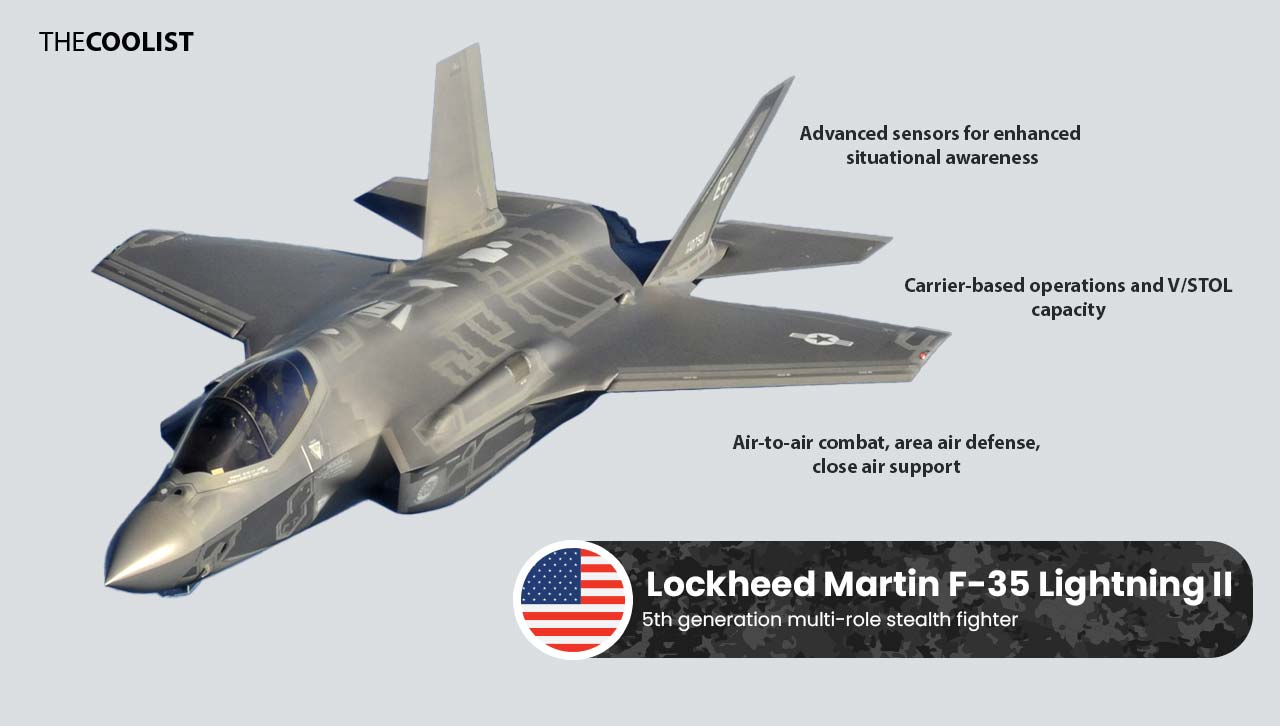
The F-35 integrates advanced stealth technology, sensors, and systems that are key drivers behind it being regarded as one of the best jet fighters in the world. The F-35 is regarded as a pivotal asset to the modern air force despite facing numerous challenges during its production, including cost overruns and delays.
The F-35 Lightning II features an empty weight of approximately 29,300 lb (13,300 kg) and a maximum takeoff weight of approximately 60,000 lb (27,000 kg), but the weight varies between the three active variants. The F-35 has a length of 51.4 ft (15.67 m), a wingspan of 35 ft (10.7 m) and a height of 14.4 ft (4.38 m).
The table below overviews the F-35’s crucial technical and performance data.
| Metric | F-35 Lightning II |
| Speed | Mach 1.6 / 1,066 kts |
| Range (combat/max) | 669NM / 1,500 NM |
| Service Ceiling | 50,000+ ft (15,240+ m) |
| Turn Rate | Not publicly disclosed |
| Turn Radius | Not publicly disclosed |
| Radar Cross Section | Extremely low (exact value classified) |
| Armament | AIM-120 AMRAAM, AIM-9X Sidewinder, GBU-12 Paveway II, etc. Internal gun for F-35A. |
| Multirole | Yes (Air-to-air combat, ground attack, reconnaissance, etc.) |
| TtW (Thrust-to-Weight Ratio) | Varies by variant and loadout; approximately 1.07 for F-35A |
| Endurance | Not publicly disclosed; enhanced with mid-air refueling |
| Survivability | High (advanced stealth, sensor fusion, electronic warfare capabilities) |
| Thrust Vectoring | No (except for F-35B’s lift fan for STOVL operations) |
The next best fighter jet, the F-22, exhibits higher top speeds, greater maneuverability, and enhanced stealth characteristics compared to the F-35. However, the F-35 distinguishes itself with more advanced sensor fusion, multirole flexibility, and broader export availability than the F-22.
2. Lockheed Martin F-22 Raptor (USA) – 5th generation air superiority fighter
The F-22 Raptor is a single-seat, twin-engine, supersonic, all-weather stealth fighter aircraft crafted for the USAF in a collaboration between Lockheed Martin Aeronautics and Boeing Defense, Space & Security. Lockheed Martin took the manufacturer lead, supplying the F-22’s airframe and weapons systems alongside final assembly, while Boeing manufactured the wings, aft fuselage, avionics integration, and training systems. Initial plans for the F-22 Raptor included a fleet of 750 Advanced Tactical Fighters (ATFs), but due to high costs and other factors, only 187 production aircraft were procured by 2009, with the final delivery in 2012.
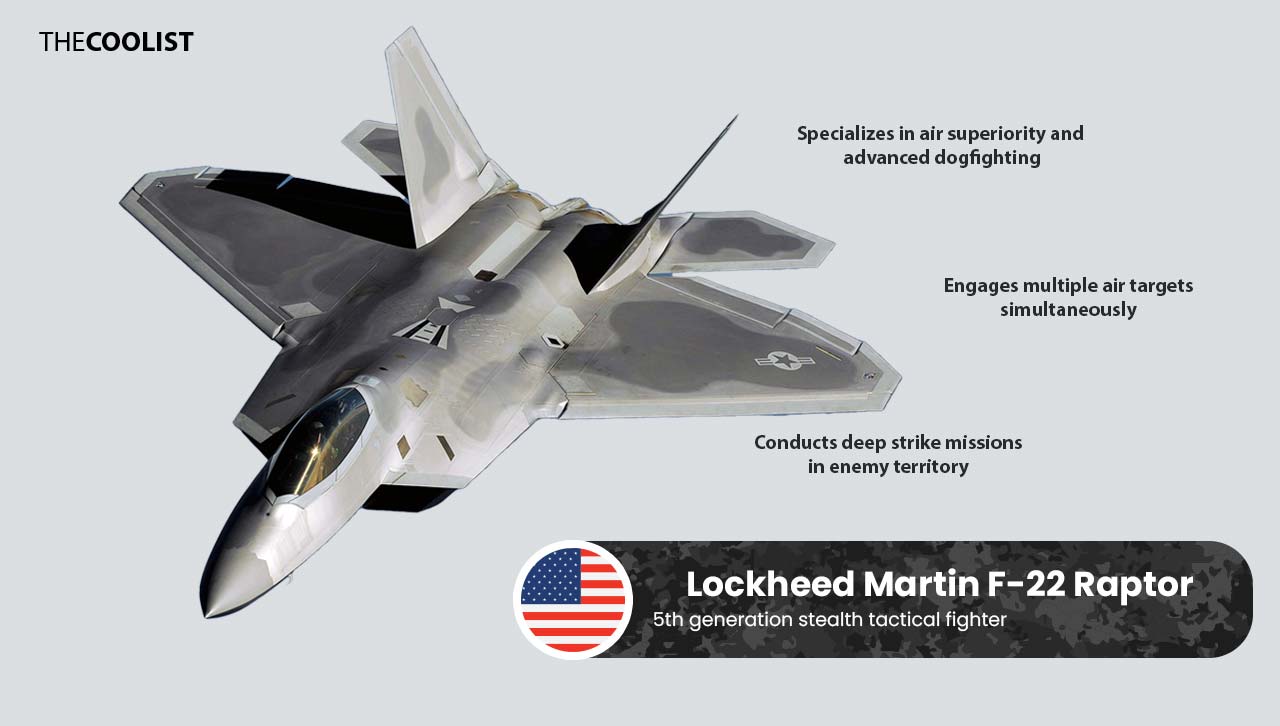
The Raptor made its inaugural flight on September 7, 1997, before being formally introduced to service on December 15, 2005. The F-22 Raptor’s original design focused on air superiority, but its current capabilities extend to ground attack, electronic warfare, and signals intelligence. That said, the F-22 Raptor is still the best air superiority fighter in the world thanks to its unmatched air combat capabilities and a blend of stealth, aerodynamic performance, and advanced mission systems.
The F-22 Raptor boasts an empty weight of 31,670 lb (14,365 kg) and a maximum takeoff weight of 60,000 lb (27,000 kg). The jet’s dimensions include a length of 62.08 ft (18.92 m), a wingspan of 44.50 ft (13.56 m), and a height of 16.42 ft (5.00 m).
The table below shows the vital technical and performance statistics of the Lockheed Martin F-22 Raptor.
| Metric | F-22 Raptor |
| Speed | Mach 2.25+ / 1,500 kts |
| Range (combat/max) | 460 NM /1,600 NM |
| Service Ceiling | 65,000+ ft (19,812+ m) |
| Turn Rate | Not publicly disclosed; highly agile |
| Turn Radius | Not publicly disclosed; small due to thrust vectoring |
| Radar Cross Section | Very low (exact value classified) |
| Armament | 6 x AIM-120 AMRAAM, 2 x AIM-9 Sidewinder, 1 x 20mm M61A2 Vulcan cannon, etc. |
| Multirole | Yes (Air superiority, ground attack, intelligence, etc.) |
| TtW (Thrust-to-Weight Ratio) | Approximately 1.08 (when loaded) |
| Endurance | Not publicly disclosed; enhanced with mid-air refueling |
| Survivability | High (stealth, advanced avionics, supercruise) |
| Thrust Vectoring | Yes (2D) |
The next best fighter on our list, the Su-57, features advanced stealth capabilities, supercruise, and integrated avionics that are comparable to those of the F-22. However, the F-22 still maintains an edge over the Su-57 in stealth design, higher speed, and overall air superiority performance.
3. Sukhoi Su-57 Felon (Russia) – 5th generation multirole stealth fighter
The Sukhoi Su-57 Felon is a twin-engine, single-seat, stealth multirole jet fighter manufactured for the Russian Air Force and Navy by the Sukhoi Design Bureau under the guidance of Mikhail Simonov. The Su-57 took its inaugural flight on January 29, 2010, and entered active service in late 2020. The jet’s introduction marks Russia’s foray into the fifth generation of fighters with an air superiority jet that’s capable of ground attack, electronic warfare, and reconnaissance missions. The Su-57’s avant-garde stealth technology, supercruise capabilities, and advanced avionics set it apart from comparable jet fighters and earn its spot as one of the best in the world.
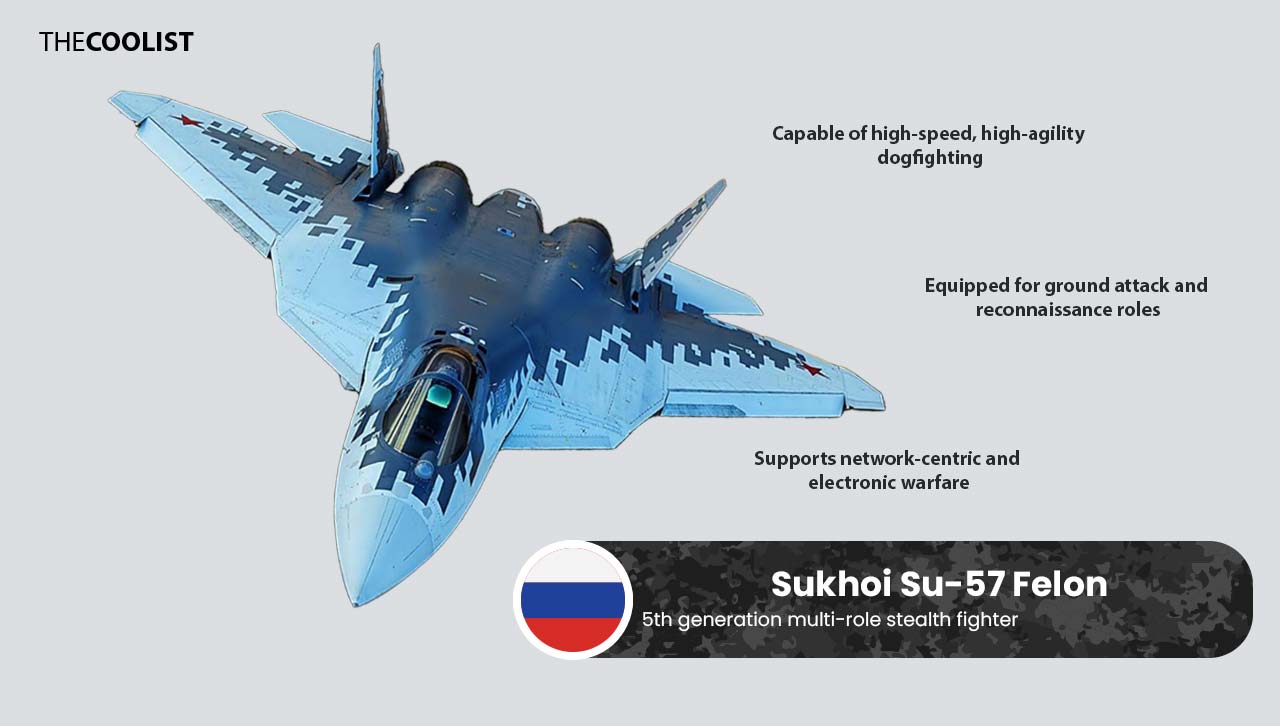
The Su-57 Felon has an approximate empty weight of 39,020 lb (17,700 kg) and measures 66.88 ft (20.4 m) in length with a wingspan of 46.59 ft (14.2 m) and a height of 15.26 ft (4.65 m).
The table below shows the key tech and performance specs of the Sukjoi Su-57 Felon.
| Metric | Sukhoi Su-57 Felon |
| Speed | Mach 2.0 / 1,333 kts |
| Range (combat/max) | 810 NM / 2,400 NM |
| Service Ceiling | 65,000 ft (20,000 m) |
| Turn Rate | Not publicly disclosed |
| Turn Radius | Not publicly disclosed |
| Radar Cross Section | Low (specific value not publicly disclosed) |
| Armament | R-77 air-to-air missiles, Kh-35U anti-ship missiles, KAB-250 satellite-guided bombs, etc. |
| Multirole | Yes (Air superiority, ground attack, reconnaissance, etc.) |
| TtW (Thrust-to-Weight Ratio) | Approximately 1.16 (when loaded) |
| Endurance | Not publicly disclosed |
| Survivability | High (stealth features, advanced avionics) |
| Thrust Vectoring | Yes (3D) |
The next fighter jet, the J-20, demonstrates significant stealth characteristics and a focus on beyond-visual-range combat, contrasting with the Su-57’s emphasis on maneuverability, close-range dogfighting capabilities, and traditional Russian fighter robustness.
4. Chengdu J-20 Mighty Dragon (China) – 5th generation multirole stealth fighter
The Chengdu J-20 Mighty Dragon is a fifth-generation twin-engine, single-seat, stealth multirole fighter aircraft developed for China’s People’s Liberation Army Air Force (PLAAF) by the Chengdu Aerospace Corporation. The J-20 Mighty Dragon had its maiden flight on January 11, 2011, and was commissioned into military service on March 10, 2017. The Chengdu J-20’s role covers air-to-air combat and ground attacks, but the fighter jet can be configured with electronic warfare capabilities. The Mighty Dragon is viewed as one of the best jet fighters in the world thanks to its winning combination of stealth technology, advanced radar systems, and high agility.
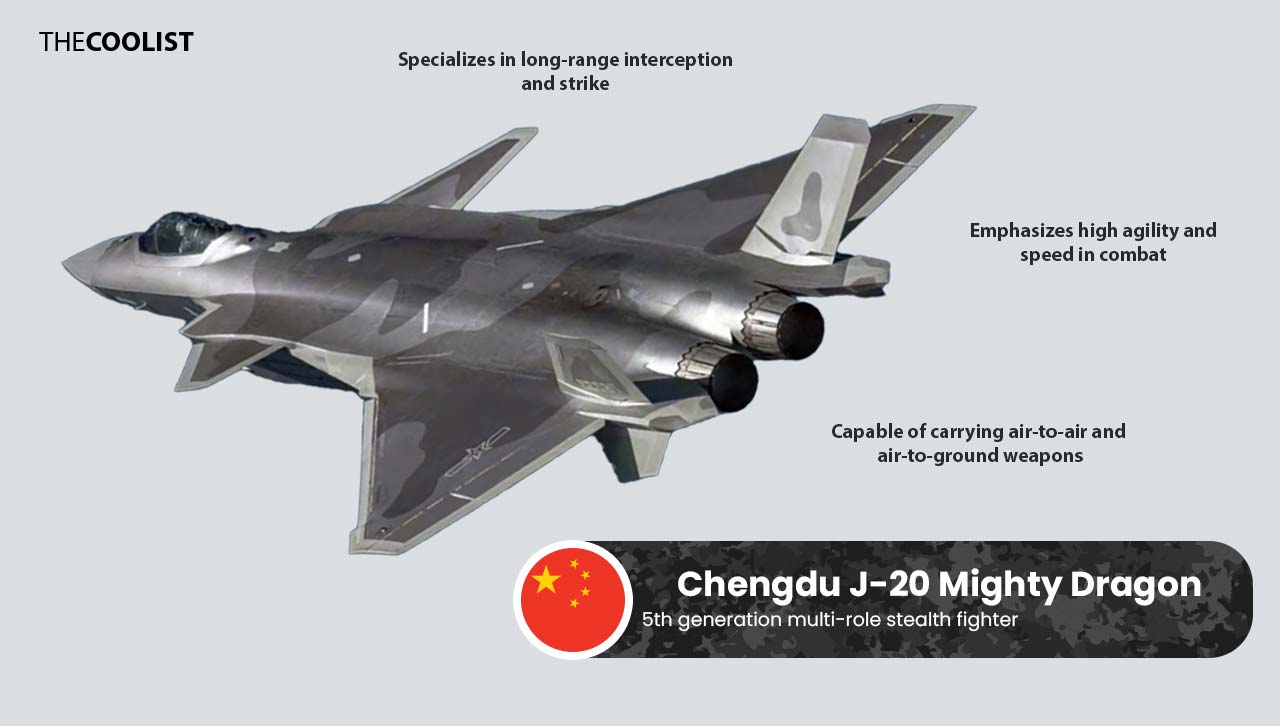
The Chengdu J-20 Mighty Dragon has an estimated empty weight of 43,000 lb (19,500 kg), a length of 66.8 ft (20.3 m), a wingspan of 44.2 ft (13.5 m) and a height of 15.2 ft (4.6 m).
The below table showcases the technical and performance data of the Chengdu J-20 Mighty Dragon.
| Metric | Chengdu J-20 Mighty Dragon |
| Speed | Mach 2.0 / 1,333 kts |
| Range (combat/max) | 1,100 NM / 3,000 NM |
| Service Ceiling | 66,000 ft (20,000 m) |
| Turn Rate | Not publicly disclosed |
| Turn Radius | Not publicly disclosed |
| Radar Cross Section | Low (specific value not publicly disclosed) |
| Armament | PL-15 and PL-10 air-to-air missiles, various air-to-ground missiles, and precision-guided munitions. |
| Multirole | Yes (Air superiority, ground attack, etc.) |
| TtW (Thrust-to-Weight Ratio) | Not publicly disclosed |
| Endurance | Not publicly disclosed |
| Survivability | High (advanced stealth design, radar-absorbing materials) |
| Thrust Vectoring | No (as of the last update) |
The next best fighter is the MiG-29, and it excels in agility, high angle of attack performance, and short-range air superiority, which contrasts the J-20’s strengths in stealth, longer-range engagements, and advanced sensor integration.
5. Mikoyan MiG-29 Fulcrum (Russia) – 4th generation air superiority fighter
The Mikoyan MiG-29 Fulcrum is a Soviet twin-engine, single-seat jet fighter aircraft that’s a product of the USSR’s Mikoyan Design Bureau, specifically its chief designer, Rostislav A. Belyakov. The MiG-29, developed to counter Western aircraft like the F-15 and F-16, took its maiden flight on October 6, 1977, and formally entered the Soviet Air Force in 1982. The MiG-29’s capabilities have expanded over the years to include multi-role functions, which include air defense, ground attack, and tactical nuclear strike operations. The fighter jet comes equipped with advanced aerodynamics, a powerful radar system, and short takeoff and landing (STOL) capabilities. These characteristics make the MiG-29 an iconic asset of the Russian and Soviet militaries and one of the most highly respected jet fighters in the world. Today, the MiG-29 is in active service in the air forces of over twenty nations.
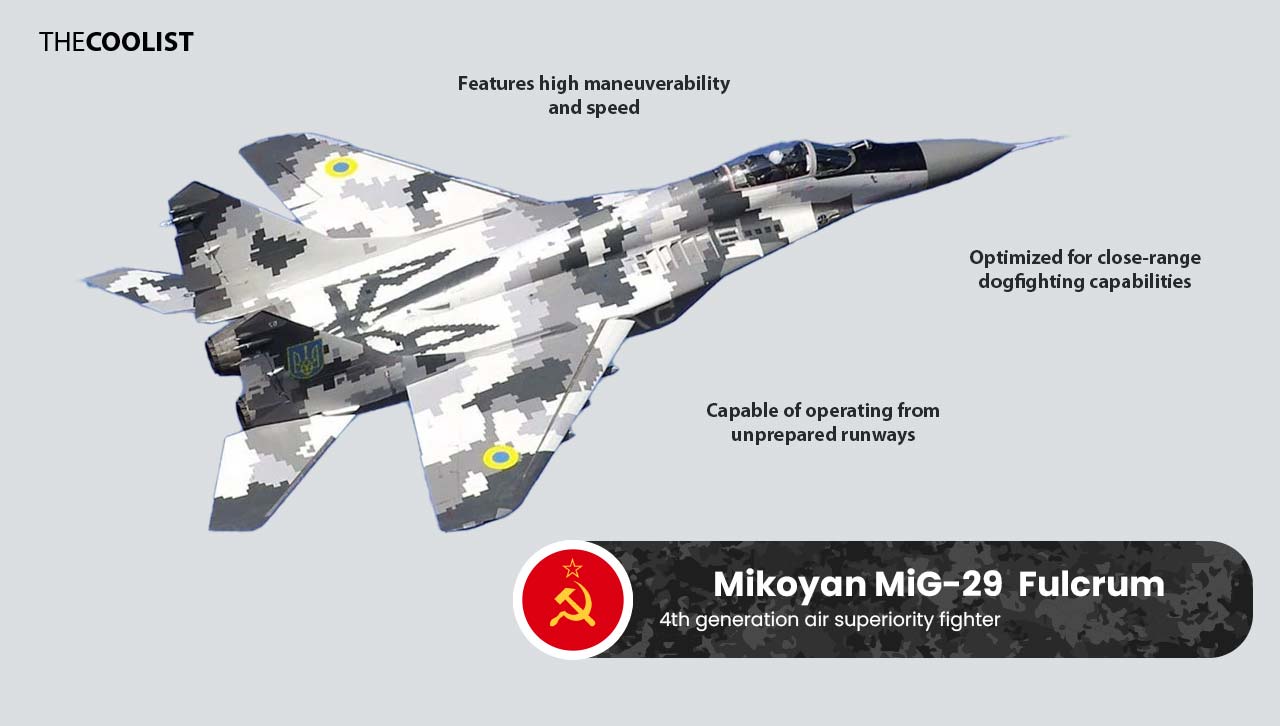
The Mikoyan MiG-29 Fulcrum has an empty weight of approximately 24,030 lb (10,900 kg). The MiG-29 is 56.9 ft (17.32 m) long, has a wingspan of 37.3 ft (11.36 m), and a height of 15.3 ft (4.73 m).
The table below shows the technical and performance specifications of the Mikoyan MiG-29 Fulcrum.
| Metric | Mikoyan MiG-29 Fulcrum |
| Speed | Mach 2.3 / 1,533 kts |
| Range (combat/max) | 490 NM / 770 NM |
| Service Ceiling | 59,100 ft (18,000 m) |
| Turn Rate | Not publicly disclosed |
| Turn Radius | Not publicly disclosed |
| Radar Cross Section | Not publicly disclosed |
| Armament | R-27R, R-73, R-60M missiles, 30mm GSh-30-1 cannon, etc. |
| Multirole | Yes (Primarily air superiority, but capable of ground attack) |
| TtW (Thrust-to-Weight Ratio) | Approximately 0.92 |
| Endurance | Not publicly disclosed |
| Survivability | Moderate (equipped with advanced radar and infrared search and track system) |
| Thrust Vectoring | No |
The next best jet fighter, the F/A-18 Super Hornet, offers excellent carrier-based versatility, multirole capabilities, and robust electronic warfare systems. In comparison, the MiG-29 shines with its superior dogfighting prowess, acceleration, and climb rate.
6. Boeing F/A-18 Super Hornet (USA) – 4th generation multirole fighter
The Boeing F/A-18 Super Hornet is an American twin-engine, carrier-capable, multi-role fighter aircraft developed by Boeing Defense, Space & Security. The Super Hornet was conceived to resolve the United States Navy’s need for an upgraded carrier-based fighter and is considered to be the evolutionary advancement of the McDonnell Douglas F/A-18 Hornet. The Super Hornet formally entered active service in 1999 following its first flight on November 29, 1995. The F/A-18 Super Hornet was initially designed for air superiority, but its versatility led to an expansion of its duties to precision air-to-ground strikes, fighter escorts, close air support, suppression of enemy air defenses, maritime strikes, and reconnaissance missions. Today, the Super Hornet plays a crucial role in maintaining naval air operations and is the backbone of the U.S. Navy’s carrier jet fighters. The plane’s enhanced avionics, greater fuel capacity, and improved aerodynamics mark it as one of the best fighter jets in the world.
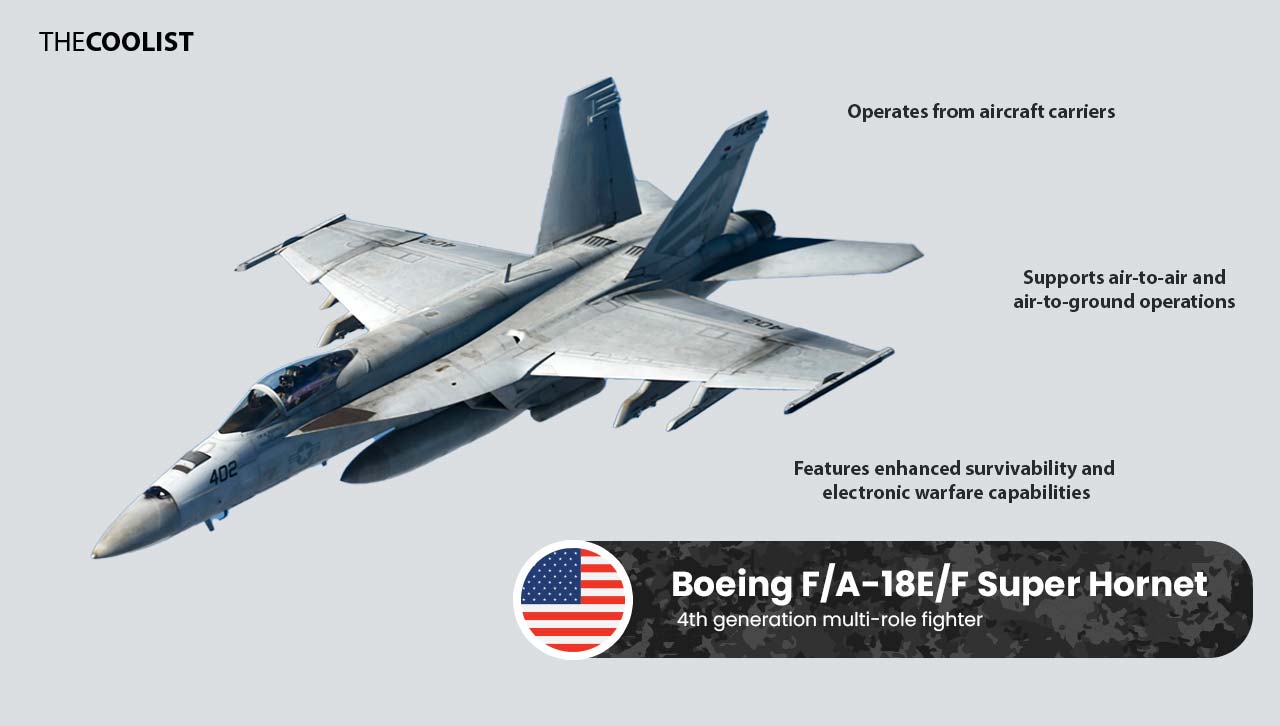
The Boeing F/A-18 Super Hornet has an empty weight of approximately 32,081 lb (14,552 kg), a length of 60.3 ft (18.5 m), a wingspan of 44.9 ft (13.68 m) with wingtips folded, and a height of 16 ft (4.88 m).
The table below depicts the technical and performance specifications of the Boeing F/A-18 Super Hornet.
| Metric | Boeing F/A-18 Super Hornet |
| Speed | Mach 1.6 / 1,067 kts |
| Range (combat/max) | 1,275 NM / 489 NM |
| Service Ceiling | 50,000+ ft (15,240+ m) |
| Turn Rate | Not publicly disclosed |
| Turn Radius | Not publicly disclosed |
| Radar Cross Section | Not publicly disclosed, but reduced compared to legacy Hornets |
| Armament | AIM-9 Sidewinder, AIM-120 AMRAAM, AGM-88 HARM, AGM-154 JSOW, M61 Vulcan cannon, etc. |
| Multirole | Yes (Air-to-air combat, ground attack, electronic warfare, etc.) |
| TtW (Thrust-to-Weight Ratio) | Approximately 0.93 (when loaded) |
| Endurance | Not publicly disclosed; enhanced with mid-air refueling |
| Survivability | High (advanced avionics, reduced radar signature, electronic countermeasures) |
| Thrust Vectoring | No |
The next best fighter jet, the Dassault Rafale, stands out with its exceptional maneuverability, advanced avionics, and versatile multirole capabilities. These characteristics contrast with the F/A-18 Super Hornet’s focus on carrier operations, mission adaptability, and electronic warfare strength.
7. Dassault Rafale (France) – 4th generation multirole fighter
The Dassault Rafale is a French twin-engine, multi-role fighter aircraft manufactured by Dassault Aviation. The Dassault Rafale emerged from the need to consolidate the French Air Force’s and Navy’s varied fighter lineup into a singular, flexible platform, and entered service in 2001. The Rafale’s versatile design allows it to perform a wide array of missions, including air-to-air combat, ground attack, in-depth strikes, reconnaissance, and nuclear deterrence. Advanced avionics, a comprehensive electronic warfare system, and a modular weapons approach make the Rafale a cornerstone of the French aerial assets, and the jet is widely considered one of the best fighters in the world.
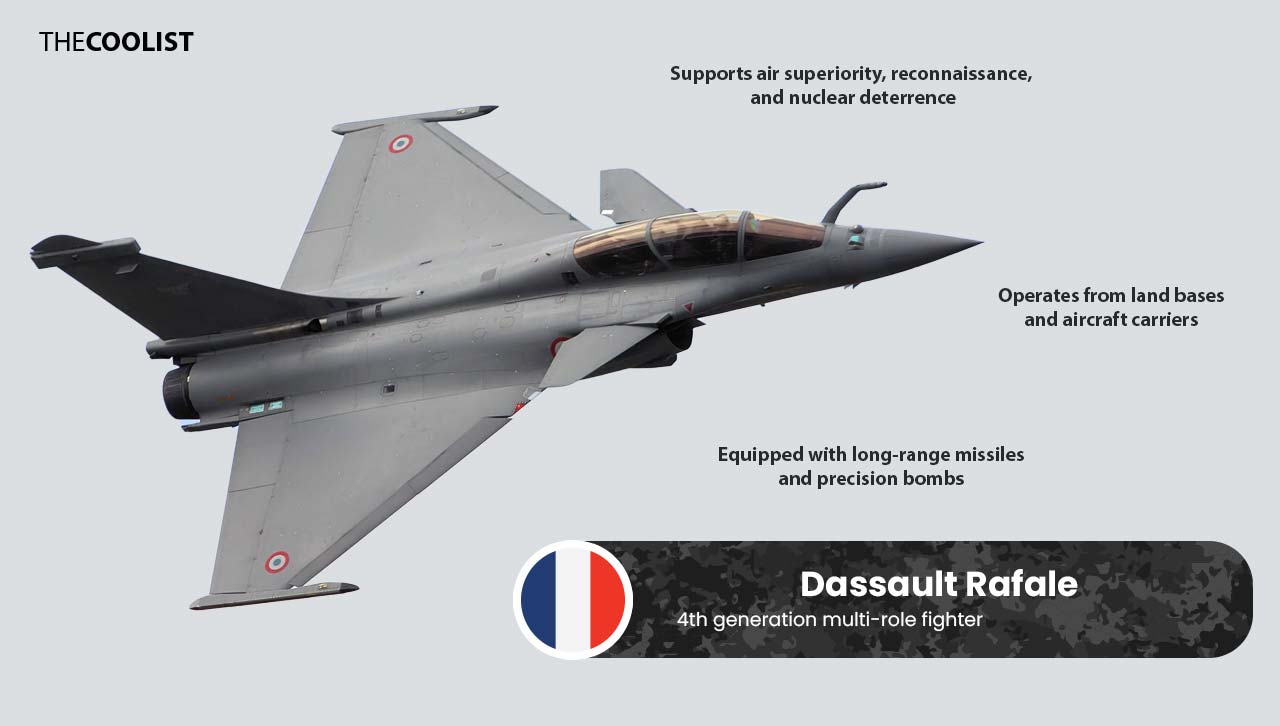
The Dassault Rafale has an empty weight of 22,000 lb (10,000 kg) and measures 50.1 ft (15.27 m) long, with a wingspan of 35.8 ft (10.9 m), and a height of 17.5 ft (5.34 m).
The following table outlines the technical and performance data of the Dassault Rafale.
| Metric | Dassault Rafale |
| Speed | Mach 1.8 / 1,200 kts |
| Range (combat/max) | 1,000 NM / 2,000 NM |
| Service Ceiling | 50,000 ft (15,235 m) |
| Turn Rate | Not publicly disclosed |
| Turn Radius | Not publicly disclosed |
| Radar Cross Section | Not publicly disclosed, but features some radar-absorbent materials |
| Armament | MICA, METEOR air-to-air missiles, SCALP cruise missiles, AASM Hammer, 30mm GIAT 30/M791 autocannon, etc. |
| Multirole | Yes (Air-to-air combat, ground attack, nuclear deterrence, etc.) |
| TtW (Thrust-to-Weight Ratio) | Approximately 0.98 |
| Endurance | Not publicly disclosed; capability for extended missions with mid-air refueling |
| Survivability | High (advanced avionics, Spectra electronic warfare system) |
| Thrust Vectoring | No |
The next best fighter jet, the Eurofighter Typhoon, is renowned for its high agility, supersonic performance, and advanced air-to-air prowess. These qualities present a contrast to the Dassault Rafale’s balanced blend of air-to-air and air-to-ground capabilities and overall versatility in various combat scenarios.
8. Eurofighter Typhoon (Multi-national) – 4th generation multirole fighter
The Eurofighter Typhoon is a twin-engine, canard-delta wing, multirole fighter aircraft of European origin that entered service in 2003. The Typhoon was developed to meet the need for a next-generation air defense aircraft in several European countries and is a collaborative effort of the UK’s BAE Systems, Italy’s Leonardo, and Germany’s Airbus Defence and Space. Each consortium member was responsible for a specific portion of the aircraft’s design and production during the project.
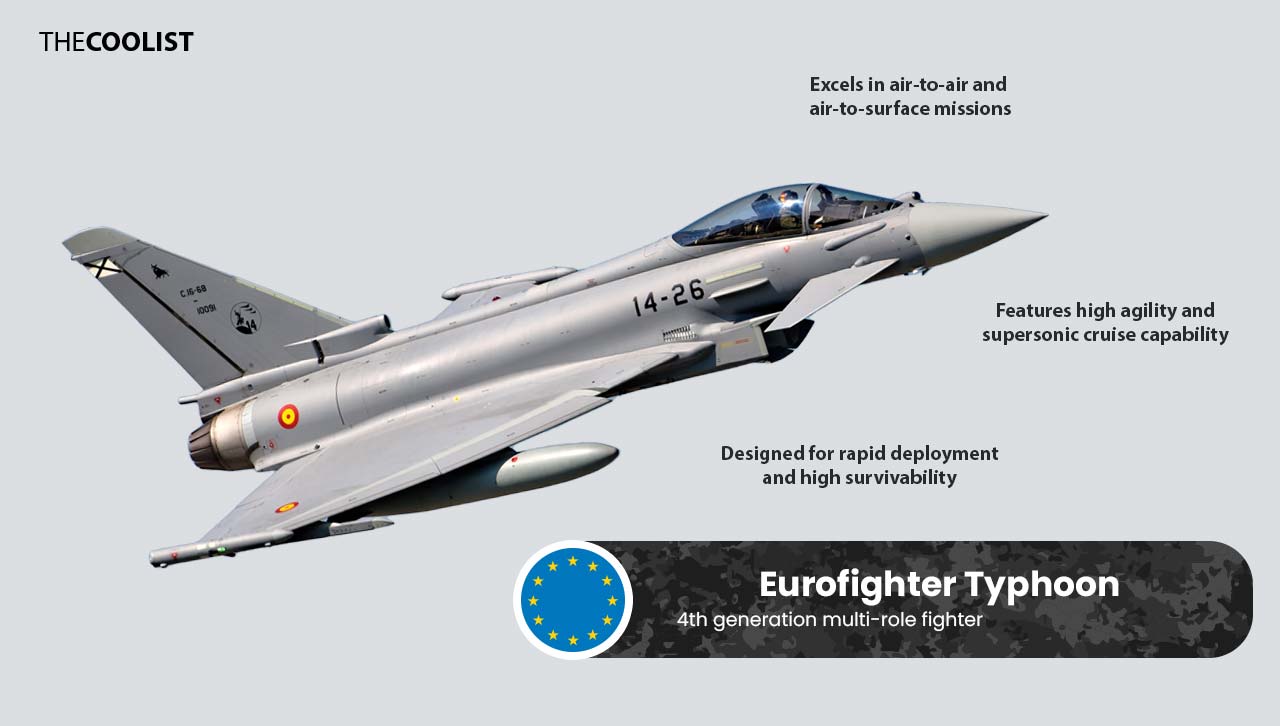
The incorporation of advanced avionics, high agility, and a robust airframe makes the Eurofighter Typhoon an adaptable fighter jet that’s capable of air defense, ground attack, reconnaissance, and electronic warfare. This adaptability makes the Eurofighter Typhoon one of the world’s greatest fighters.
The Eurofighter Typhoon has an approximate empty weight of 24,250 lb (11,000 kg), a length of 52.5 ft (16 m), a wingspan of 35.9 ft (10.95 m), and a height of 17.4 ft (5.28 m)
The table below outlines the performance and technical specifications of the Eurofighter Typhoon.
| Metric | Eurofighter Typhoon |
| Speed | Mach 2.0 / 1,333 kts |
| Range (combat/max) | 750 NM / 1,600 NM |
| Service Ceiling | 65,000 ft (19,812 m) |
| Turn Rate | Not publicly disclosed |
| Turn Radius | Not publicly disclosed |
| Radar Cross Section | Not publicly disclosed, but designed with reduced radar signature |
| Armament | AIM-132 ASRAAM, AIM-120 AMRAAM, Meteor missiles, Paveway IV bombs, Mauser BK-27 27mm cannon, etc. |
| Multirole | Yes (Air-to-air combat, ground attack, reconnaissance, etc.) |
| TtW (Thrust-to-Weight Ratio) | Approximately 1.15 |
| Endurance | Not publicly disclosed; capability for extended operations with mid-air refueling |
| Survivability | High (advanced avionics, defensive aids subsystem) |
| Thrust Vectoring | No |
The next best fighter jet, the Su-35, excels with its powerful thrust-vectoring engines, high maneuverability, and improved avionics, offering a distinct contrast to the Eurofighter Typhoon’s focus on superior aerodynamics and beyond-visual-range engagement capabilities.
9. Sukhoi Su-35 Flanker-E (Russia) – 4th++ generation air superiority fighter
The Sukhoi Su-35 Flanker-E is a twin-engine, supermaneuverable multirole fighter aircraft manufactured by Russia’s Sukhoi Company. The Sukhoi SU-35 Flanker-E is the modernized version of the original Su-27 Flanker, designed by Mikhail Simonov, which entered service in 2014. Sukhoi equipped the Su-35 with enhanced avionics, formidable engine thrust, and a refined aerodynamic structure. The Su-35’s design and avionics empower it to undertake an expansive range of missions, from ground attack and maritime strike to electronic warfare, and all contribute to its position as one of the best fighter jets in the world.
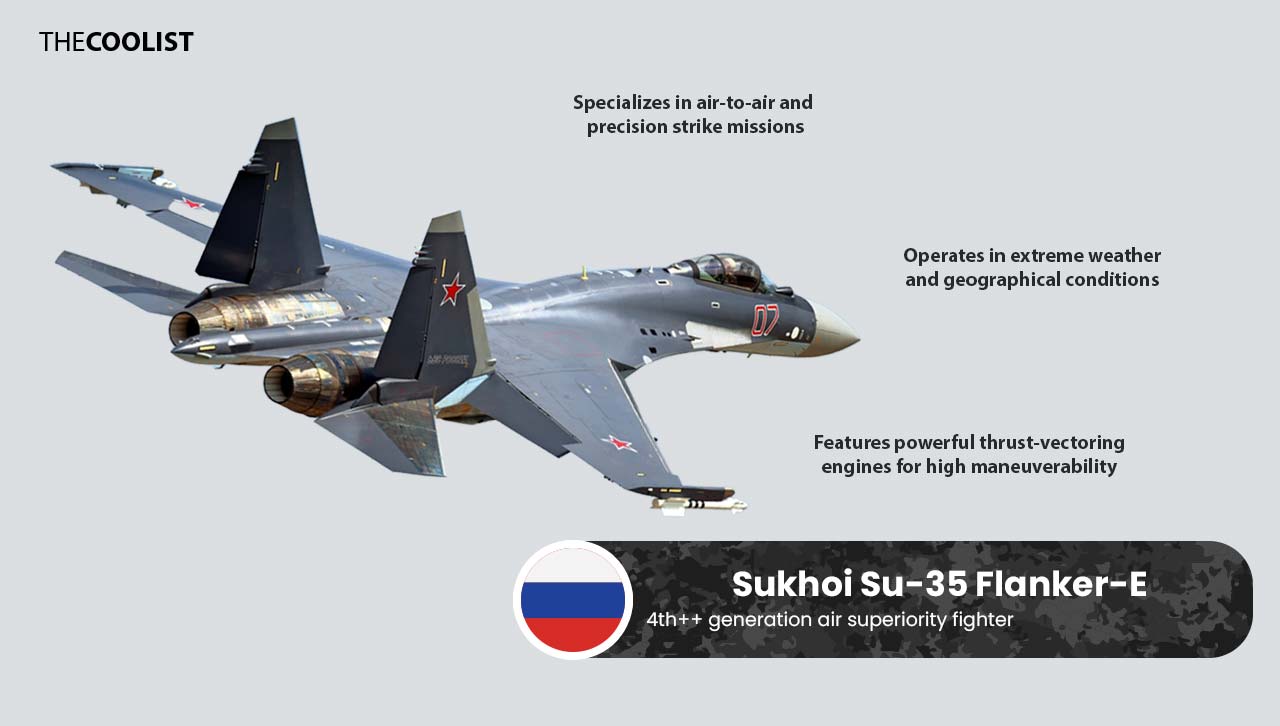
The Sukhoi Su-35 Flanker-E has an empty weight of approximately 39,680 lb (18,000 kg), a length of 72.9 ft (22.2 m), a wingspan of 50.2 ft (15.3 m), and a height of 19.4 ft (5.9 m).
The table below shows the available technical and performance details for the Sukhoi Si-35 Flanker-E.
| Metric | Sukhoi Su-35 Flanker-E |
| Speed | Mach 2.25 / 1,500 kts |
| Range (combat/max) | 860 NM / 1,900 NM |
| Service Ceiling | 59,000 ft (18,000 m) |
| Turn Rate | Not publicly disclosed |
| Turn Radius | Not publicly disclosed |
| Radar Cross Section | Not publicly disclosed, but some design elements for reduced radar visibility |
| Armament | R-77, R-27, R-73 air-to-air missiles, Kh-31, Kh-59 air-to-ground missiles, GSh-30-1 30mm cannon, etc. |
| Multirole | Yes (Air-to-air combat, ground attack, etc.) |
| TtW (Thrust-to-Weight Ratio) | Approximately 1.13 |
| Endurance | Not publicly disclosed |
| Survivability | High (advanced avionics, electronic countermeasures) |
| Thrust Vectoring | Yes (3D) |
The next best fighter jet, the J-10, is recognized for its agility, delta wing design, and effective multirole performance, as compared to the Su-35’s exceptional air superiority focus, superior maneuverability, and enhanced thrust-vectoring capabilities.
10. Chengdu J-10 Firebird (China) – 4th generation multirole fighter
The Chengdu J-10 Firebird is a single-engine, delta-wing, multi-role jet fighter manufactured by the Chengdu Aircraft Industry Group under the supervision of chief designer, Song Wencong. China’s ambition to build a modern fighter to rival Western jets was the driving force behind the J-10’s design. The J-10 entered service with the PLAAF in 2006 as a fighter that’s suitable for a range of operations, including interception, ground attack, and anti-ship missions. Today, the Firebird is recognized as one of the best fighter jets in the world thanks to its blend of aerodynamic efficiency, robust avionics, and a versatile weapon suite.

The Chengdu J-10 Firebird reports an empty weight of approximately 28,600 lb (13,000 kg). The Firebird rolls off the line with a length of 53.8 ft (16.4 m), a wingspan of 31.8 ft (9.7 m), and a height of 18.2 ft (5.6 m).
The below table further illustrates the core technical and performance details of the Chengdu J-10 Firebird.
| Metric | Chengdu J-10 Firebird |
| Speed | Mach 1.8 / 1,200 kts |
| Range (combat/max) | 670 NM / 1,000 NM |
| Service Ceiling | 59,000 ft (18,000 m) |
| Turn Rate | Not publicly disclosed |
| Turn Radius | Not publicly disclosed |
| Radar Cross Section | Not publicly disclosed |
| Armament | PL-8, PL-12 air-to-air missiles, LS-6 satellite-guided bombs, 23mm twin-barrel cannon, etc. |
| Multirole | Yes (Air-to-air combat, ground attack) |
| TtW (Thrust-to-Weight Ratio) | Approximately 1.095 |
| Endurance | Not publicly disclosed |
| Survivability | High (advanced avionics, electronic warfare capabilities) |
| Thrust Vectoring | No |
The next top jet fighter, the Saab JAS 39 Gripen, is lauded for its cost-effectiveness, ease of maintenance, and advanced network-centric warfare capabilities, setting it apart from the J-10’s emphasis on agility, thrust-to-weight ratio, and versatility.
11. Saab JAS 39 Gripen (Sweden) – 4th generation multirole fighter
The Saab JAS 39 Gripen is a single-engine, delta-wing, lightweight multirole fighter manufactured in Sweden by the Saab Group. The JAS 39 reflects Sweden’s need for an agile, modern fighter. The Saab JAS 39 Gripen entered the Swedish Air Force in 1996, following its maiden flight on December 9, 1988. Since then, the JAS 39 has garnered international acclaim as one of the premier fighter jets thanks to its adaptability, efficiency, and prowess in contemporary air combat scenarios. The Gripen was conceived as an air defense vehicle; however, its modular design caters to a vast array of roles, from precision strikes and reconnaissance to electronic warfare.
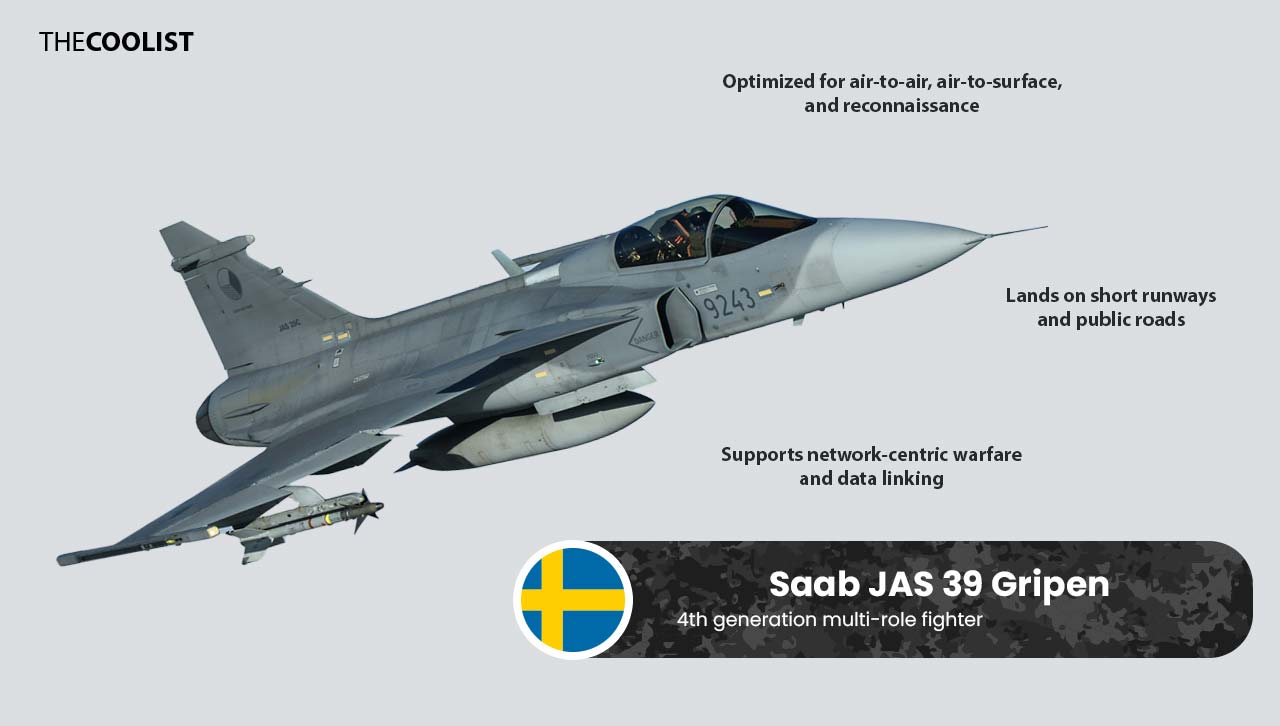
The Saab JAS 39 Gripen boasts an empty weight of around 14,330 lb (6,500 kg), while its dimensions extend to a length of 46.3 ft (14.1 m), a wingspan of 27.5 ft (8.4 m), and a height of 14.8 ft (4.5 m).
The table below shows the technical and performance specifications of the Saab JAS 39 Gripen.
| Metric | Saab JAS 39 Gripen |
| Speed | Mach 2.0 / 1,333 kts |
| Range (combat/max) | 430 NM / 1,700 NM |
| Service Ceiling | 50,000 ft (15,240 m) |
| Turn Rate | Not publicly disclosed |
| Turn Radius | Not publicly disclosed |
| Radar Cross Section | Not publicly disclosed, but features some design elements for reduced radar visibility |
| Armament | AIM-9 Sidewinder, Meteor, IRIS-T air-to-air missiles, AGM-65 Maverick, KEPD 350, various bombs, Mauser BK-27 27mm revolver cannon, etc. |
| Multirole | Yes (Air-to-air combat, ground attack, reconnaissance, etc.) |
| TtW (Thrust-to-Weight Ratio) | Approximately 0.97 |
| Endurance | Not publicly disclosed; capability for extended missions with mid-air refueling |
| Survivability | High (advanced avionics, electronic warfare suite, reduced infrared and radar signature) |
| Thrust Vectoring | No |
The next top fighter, the MiG-35, showcases modernized avionics, improved combat capabilities, and enhanced radar systems. These features differentiate it from the Saab JAS 39 Gripen’s strengths in strategic flexibility, electronic warfare, and efficient performance in various air-to-air and air-to-ground scenarios.
12. Mikoyan MiG-35 Fulcrum-F (Russia) – 4th++ generation multirole fighter
The Mikoyan MiG-35 Fulcrum-F is a twin-engine, multi-role combat aircraft developed by the Mikoyan Design Bureau as the latest addition to the renowned MiG lineup. The MiG-35’s first flight was on January 27, 2017, before it entered service in 2019. The MiG-35 is the successor to the highly respected MiG-29 and is based on the original designs from Rostislav Apollosovich Belyakov. The MiG-35’s advanced avionics, a sophisticated radar system, and enhanced thrust capabilities help it excel in air-to-air combat, ground attack, and naval missions, rightfully making it one of the best fighter jets ever built.
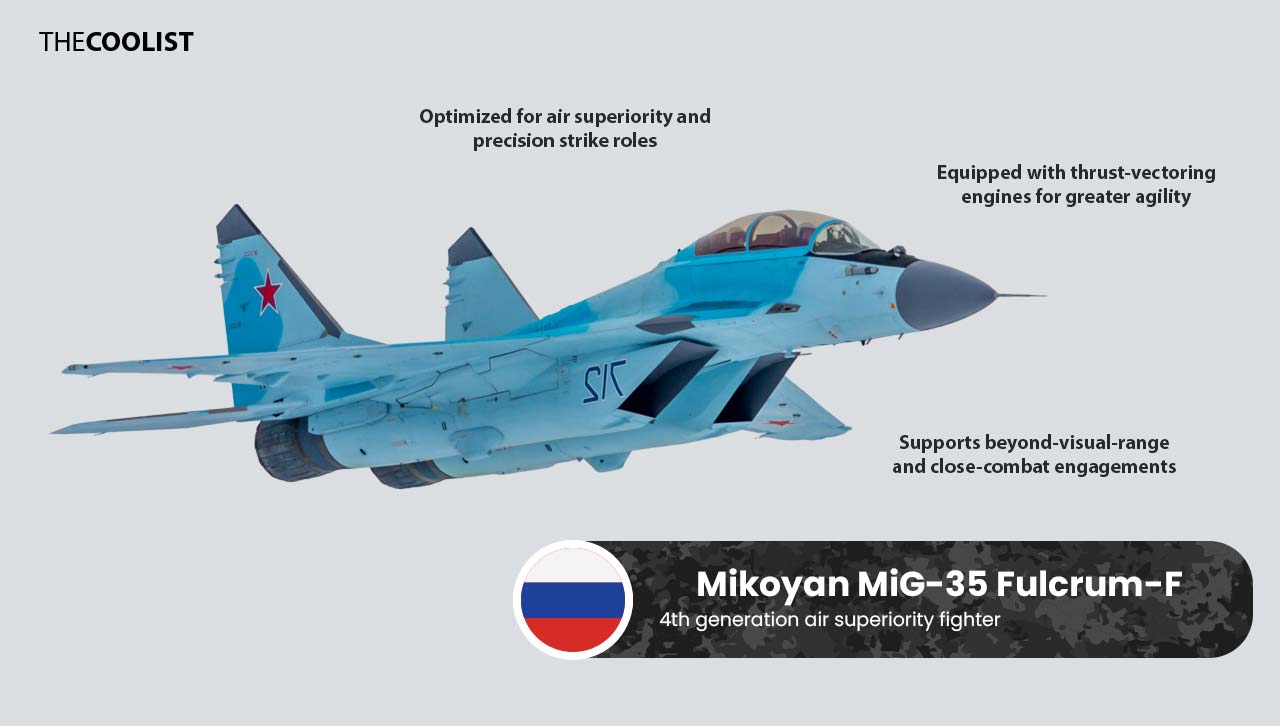
The MiG-35 Fulcrum-F has an empty weight of approximately 24,250 lb (11,000 kg) and measures 56.8 ft (17.3 m) in length, with a wingspan of 39 ft (11.9 m), and a height of 15.3 ft (4.7 m).
The following table highlights the technical and performance details of the Mikoyan MiG-35 Fulcrum-F.
| Metric | Mikoyan MiG-35 Fulcrum-F |
| Speed | Mach 2.25 / 1,500 kts |
| Range (combat/max) | 540 NM / 1,100 NM |
| Service Ceiling | 57,400 ft (17,500 m) |
| Turn Rate | Not publicly disclosed |
| Turn Radius | Not publicly disclosed |
| Radar Cross Section | Not publicly disclosed |
| Armament | R-77, R-27, R-73 air-to-air missiles, Kh-38 air-to-ground missiles, 30mm GSh-30-1 autocannon, etc. |
| Multirole | Yes (Air-to-air combat, ground attack, reconnaissance, etc.) |
| TtW (Thrust-to-Weight Ratio) | Approximately 1.03 |
| Endurance | Not publicly disclosed |
| Survivability | High (advanced avionics, electronic countermeasures) |
| Thrust Vectoring | Yes (3D) |
The next best fighter jet, the F-15E Strike Eagle, excels with its superior payload capacity, long-range strike capabilities, and proven air-to-air combat record. These features set the F-15E apart from the MiG-35’s emphasis on advanced electronic warfare systems, agility in dogfights, and modern avionics upgrades.
13. Boeing F-15E Strike Eagle (USA) – 4th generation multirole fighter
The Boeing F-15E Strike Eagle is a twin-engine, all-weather multi-role strike fighter and an advanced version of the earlier F-15. The Strike Eagle was developed by Boeing Defense, Space & Security under the leadership of chief designer Herman Barkey, and entered service in 1986. The Strike Eagle was designed for long-range, high-speed interdiction without relying on escort or electronic warfare aircraft. The advanced avionics, enhanced radar systems, and air-to-ground munitions of the Strike Eagle have earned it the reputation of one of the best jet fighters. The Strike Eagle remains a key player in the USAF’s fleet even after a three-decade-long service history.
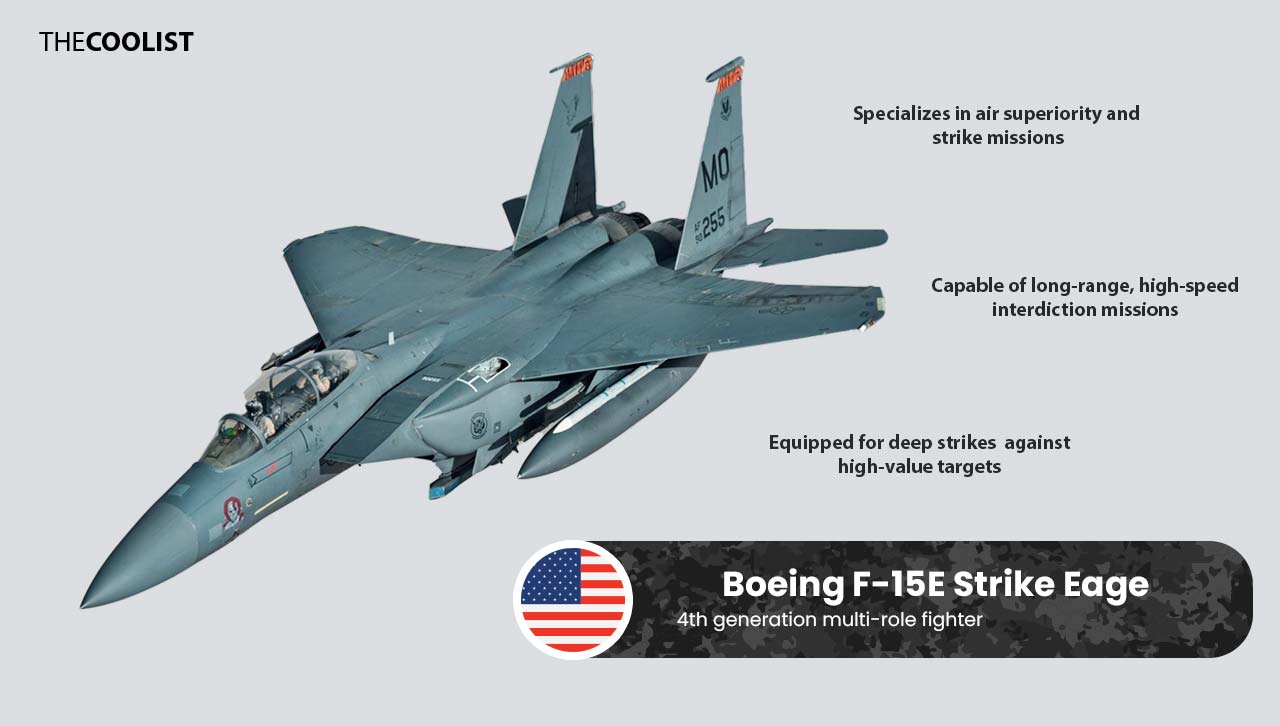
The F-15E Strike Eagle boasts an empty weight of 31,700 lb (14,300 kg). The aircraft is 63.8 ft (19.4 m) long, with a wingspan of 42.8 ft (13 m) and a height of 18.5 ft (5.6 m).
The table below offers a view of the technical and performance specifications of the F-15 Strike Eagle.
| Metric | Boeing F-15E Strike Eagle |
| Speed | Mach 2.5 / 1,650 knots |
| Range (combat/max) | 790 NM / 2,400 NM |
| Service Ceiling | 60,000 ft (18,288 m) |
| Turn Rate | Not publicly disclosed |
| Turn Radius | Not publicly disclosed |
| Radar Cross Section | Not publicly disclosed |
| Armament | AIM-9 Sidewinder, AIM-120 AMRAAM, AGM-130, AGM-65 Maverick, GBU-28, M61A1 20mm cannon, etc. |
| Multirole | Yes (Air-to-air combat, ground attack, etc.) |
| TtW (Thrust-to-Weight Ratio) | Approximately 1.12 |
| Endurance | Not publicly disclosed; capability enhanced with mid-air refueling |
| Survivability | High (advanced avionics, electronic warfare systems) |
| Thrust Vectoring | No |
The next best fighter jet, the F-16 Fighting Falcon, is renowned for its exceptional maneuverability, user-friendly interface, and versatile multirole capabilities. These characteristics offer a distinct contrast to the F-15E Strike Eagle’s focus on high payload, long-range precision strikes, and overall air superiority in both air-to-air and air-to-ground missions.
14. Lockheed Martin F-16 Fighting Falcon (USA) – 4th generation multirole fighter
The Lockheed Martin F-16 Fighting Falcon is a single-engine, multi-role fighter manufactured by Lockheed Martin’s predecessor, General Dynamics, and a team led by Harry Hillaker. The aircraft took its inaugural flight on January 20, 1974, and entered service in 1978. However, Lockheed Martin has continuously updated the aircraft with modern technology. The F-16 was initially a daytime air superiority fighter but has evolved into a successful all-weather multirole aircraft. The F-16 boasts a frameless bubble canopy for better visibility, a side-mounted control stick for ease of control, and a reclined seat to reduce the effect of g-forces on the pilot. The F-16’s compact size, coupled with its agile nature, makes it suitable for a broad spectrum of air missions. Its efficient design and state-of-the-art upgrades ensure the F-16 remains a cornerstone in many air forces many decades after entering service.
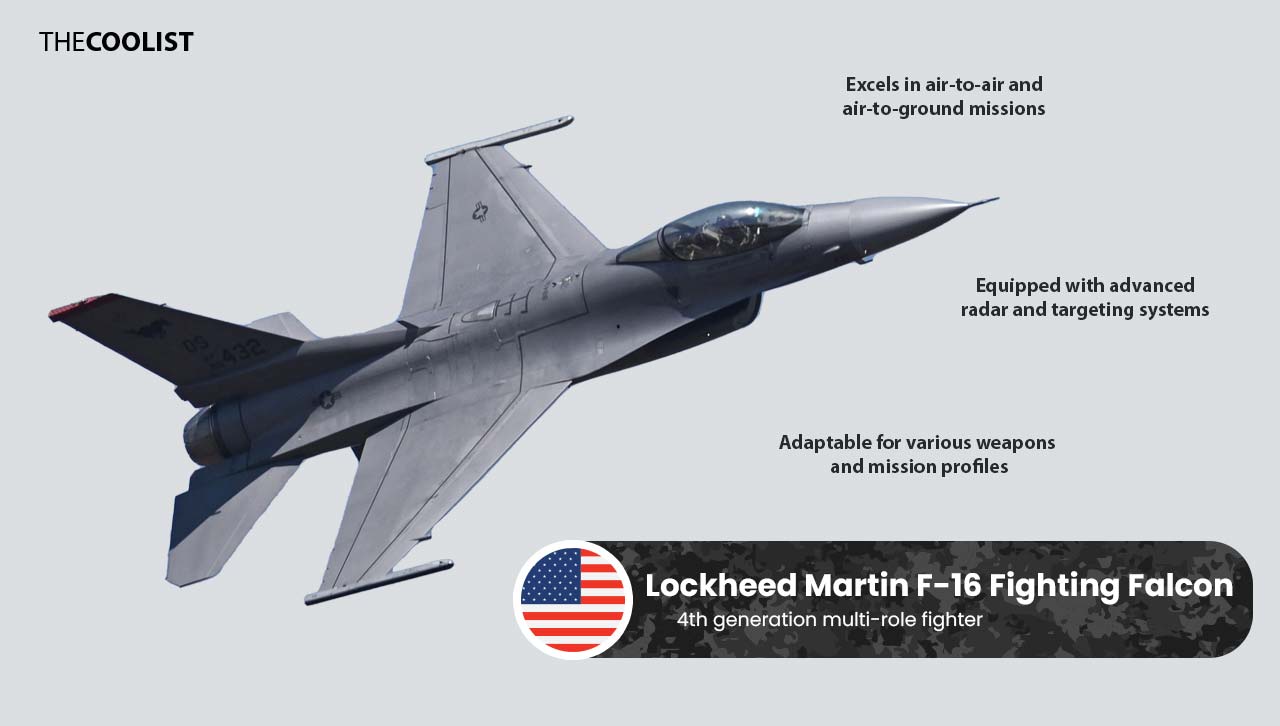
The F-16 Fighting Falcon has an operating empty weight of approximately 18,900 lb (8,570 kg) and measures 49.5 ft (15.1 m) in length. The jet has a wingspan of 32.8 ft (10 m) and stands 16 ft (4.9 m) tall.
The table below shows the technical specifications for the Lockheed Martin F-16 Fighting Falcon.
| Metric | Lockheed Martin F-16 Fighting Falcon |
| Speed | Mach 2.0 / 1,333 knots |
| Range (combat/max) | 295 NM / Ferry range: 2,280 NM |
| Service Ceiling | 50,000 ft (15,240 m) |
| Turn Rate | Not publicly disclosed |
| Turn Radius | Not publicly disclosed |
| Radar Cross Section | Not publicly disclosed |
| Armament | AIM-9 Sidewinder, AIM-120 AMRAAM, AGM-65 Maverick, various bombs, M61 Vulcan 20mm cannon, etc. |
| Multirole | Yes (Air-to-air combat, ground attack, etc.) |
| TtW (Thrust-to-Weight Ratio) | Approximately 1.095 |
| Endurance | Not publicly disclosed; capability for extended missions with mid-air refueling |
| Survivability | High (advanced avionics, electronic countermeasures) |
| Thrust Vectoring | No |
The next best fighter jet, the Shenyang J-31 Falconhawk, is noted for its stealth characteristics and potential as a carrier-based aircraft, as compared to the F-16 Fighting Falcon’s agility, close air support effectiveness, and its role as a highly maneuverable, lightweight fighter.
15. Shenyang J-31 Falconhawk (China) – 5th generation multirole stealth fighter
The Shenyang J-31 Falconhawk is a twin-engine, multi-role stealth fighter developed by the Shenyang Aircraft Corporation, a subsidiary of China’s Aviation Industry Corporation. The J-31 made its public debut on November 12, 2012, but has yet to enter service. Despite not yet being in active service, the Falconhawk combines stealth capabilities with advanced avionics and aerodynamics and is regarded as one of the top new fighters in the world. The J-31 Falconhawk features a range of modern technologies, including a diverse array of sensors, a reduced radar cross-section, and enhanced agility. These characteristics embody the J-31’s conception as a counterpart to other fifth-generation fighters and showcase China’s ambitions in the realm of stealth aircraft.
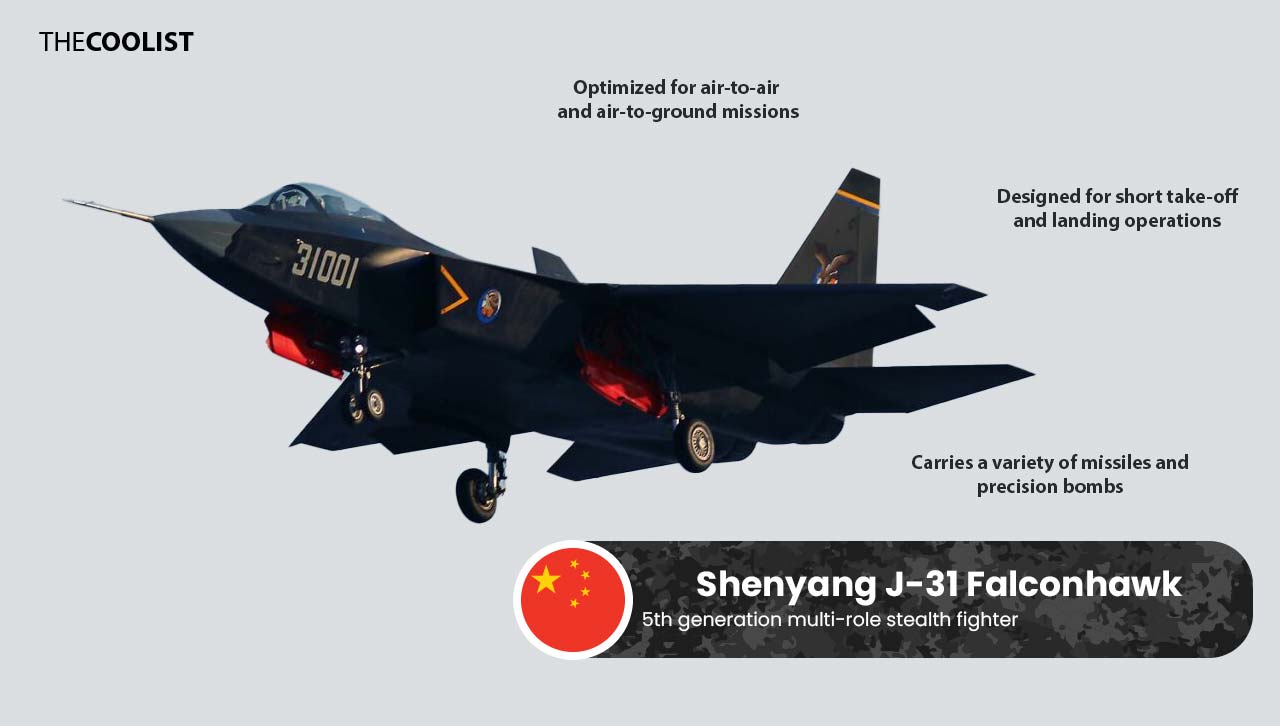
The Shenyang J-31 Falconhawk has an estimated empty weight of 28,660 lb (13,000 kg). The aircraft’s design encompasses a length of 54.8 ft (16.7 m), a wingspan of 38.4 ft (11.7 m), and a height of 15.1 ft (4.6 m).
The below table affords an in-depth look at the projected technical and performance details behind the Shenyang J-31 Falconhawk.
| Metric | Shenyang J-31 Falconhawk |
| Speed | Estimated Mach 1.8 /1,190 knots |
| Range (combat/max) | Unknown / Unknown |
| Service Ceiling | 65,000 ft (20,000 m) |
| Turn Rate | Not publicly disclosed |
| Turn Radius | Not publicly disclosed |
| Radar Cross Section | Not publicly disclosed, but stealth features are incorporated into the design |
| Armament | PL-12, PL-15 air-to-air missiles, various bombs, internal cannon (details not publicly disclosed) |
| Multirole | Yes (Air-to-air combat, ground attack) |
| TtW (Thrust-to-Weight Ratio) | Approximately 1.07 (estimated) |
| Endurance | Not publicly disclosed |
| Survivability | High (advanced avionics, stealth design) |
| Thrust Vectoring | No |
The next top fighter on our list is the Mitsubishi F-2, which features enhanced air-to-ship capabilities, advanced avionics tailored for precise ground attacks, and a larger radar cross-section than the J-31. The J-31 additionally places a heavier focus on stealth and air-to-air capabilities than the F-2.
16. Mitsubishi F-2 (Japan) – 4th generation multirole fighter
The Mitsubishi F-2 (also known as the “Viper Zero”) is a single-engine, multi-role fighter. Mitsubishi Heavy Industries and Lockheed Martin developed the jet in collaboration, and it was manufactured in Japan and the United States, entering service in 2000. The F-2 was birthed from Japan’s desire for an advanced indigenous fighter, and leveraged design elements from the F-16 Fighting Falcon. The F-2 incorporated a series of unique modifications to suit the specific defense needs of Japan. The final F-2 Viper Zero design features a large wing area, advanced avionics, and the ability to carry a diverse range of munitions. The aforementioned characteristics make the F-2 stand out as one of the premier fighter jets in active service.

The Mitsubishi F-2 has an empty weight of approximately 21,000 lb (9,527 kg), and its reported dimensions include a length of 50.5 ft (15.4 m), a wingspan of 36.7 ft (11.2 m), and a height of 15.3 ft (4.7 m). The F-2’s agility and adaptability in various aerial missions means this aircraft stands as a symbol of Japan’s advanced aerospace achievements.
The table below provides an overview of the technical specifications of the Mitsubishi F-2.
| Metric | Mitsubishi F-2 |
| Speed | Mach 2.0 / 1,333 knots |
| Range (combat/max) | 520 NM / Unknown |
| Service Ceiling | 59,000 ft (18,000 m) |
| Turn Rate | Not publicly disclosed |
| Turn Radius | Not publicly disclosed |
| Radar Cross Section | Not publicly disclosed |
| Armament | AIM-9 Sidewinder, AIM-7 Sparrow, ASM-1 and ASM-2 anti-ship missiles, various bombs, M61A1 20mm cannon, etc. |
| Multirole | Yes (Air-to-air combat, anti-ship, ground attack) |
| TtW (Thrust-to-Weight Ratio) | Approximately 0.91 |
| Endurance | Not publicly disclosed; capability enhanced with external fuel tanks |
| Survivability | High (advanced avionics, electronic warfare systems) |
| Thrust Vectoring | No |
The next top jet fighter, the KAI KF-21 Boramae, is characterized by its cutting-edge avionics, potential for stealth capabilities, and focus on air superiority and multirole missions. These characteristics set it apart from the Mitsubishi F-2’s specialized air-to-ship and ground attack proficiency, enhanced radar, and larger payload capacity.
17. KAI KF-21 Boramae (South Korea) – 4.5 generation multirole fighter
The KAI KF-21 Boramae is a twin-engine, multi-role fighter aircraft developed by Korea Aerospace Industries in collaboration with Indonesian Aerospace and with assistance from Lockheed Martin. The KAI KF-21 was unveiled on April 9, 2021, and is scheduled to enter active service in 2026. The intent behind the KF-21 was to supplement and eventually replace older fighters in the South Korean Air Force’s fleet. Its modern avionics, stealth features, and the ability to carry a vast array of weaponry give the KAI KF-21 Boramae the reputation of one of the best new fighter jets around.
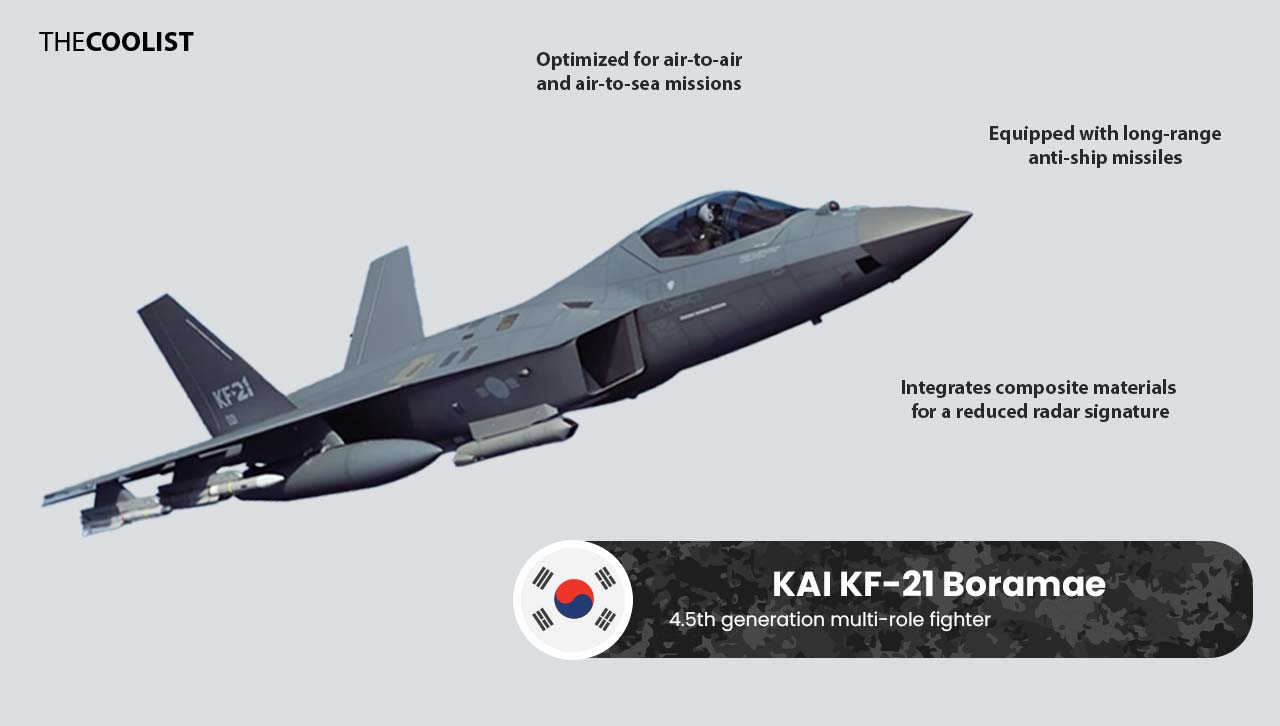
The KAI KF-21 Boramae is still in development, so its specifications are yet to be confirmed. Current estimates include a length of 55.8 ft (17 m), a wingspan of 36.4 ft (11.1 m), and a height of 15.4 ft (4.7 m). The below table provides an overview of the KAI KF-21 Boramae’s projected performance and specifications.
| Metric | KAI KF-21 Boramae |
| Speed | Estimated Mach 1.81 / 1,200 knots |
| Range (combat/max) | 540 NM / 1,550 NM |
| Service Ceiling | Not publicly disclosed |
| Turn Rate | Not publicly disclosed |
| Turn Radius | Not publicly disclosed |
| Radar Cross Section | Not publicly disclosed, but features stealth design elements |
| Armament | AIM-9 Sidewinder, AIM-120 AMRAAM, AGM-65 Maverick, various bombs (specifics not yet fully disclosed) |
| Multirole | Yes (Air-to-air combat, ground attack, etc.) |
| TtW (Thrust-to-Weight Ratio) | Not publicly disclosed |
| Endurance | Not publicly disclosed |
| Survivability | High (advanced avionics, stealth design elements) |
| Thrust Vectoring | No |
The next best fighter jet, the Sukhoi Su-30MKI, is renowned for its exceptional maneuverability and strength in long-range engagements. In contrast, the KAI KF-21 Boramae is focused on integrating advanced stealth technology and modern avionics, achieving a balance between air superiority and versatile multirole capabilities.
18. Sukhoi Su-30MKI Flanker-H (Russia/India) – 4th generation multirole fighter
The Sukhoi Su-30MKI Flanker-H is a twin-engine, long-range multi-role fighter aircraft co-developed by Russia’s Sukhoi Design Bureau and India’s Hindustan Aeronautics Limited (HAL). The Su-30MKI is tailored specifically for the Indian Air Force. This variant of the Su-30 series was born out of a need to modernize India’s aerial combat capabilities and boasts advanced avionics, supermaneuverability, and a thrust-vectoring engine system. The Flanker-H is one of India’s best and most versatile fighters, blending Russian airframe expertise with global technological enhancements. The Su-30MKI made its inaugural flight on July 1, 1997, and entered active service in 2002.
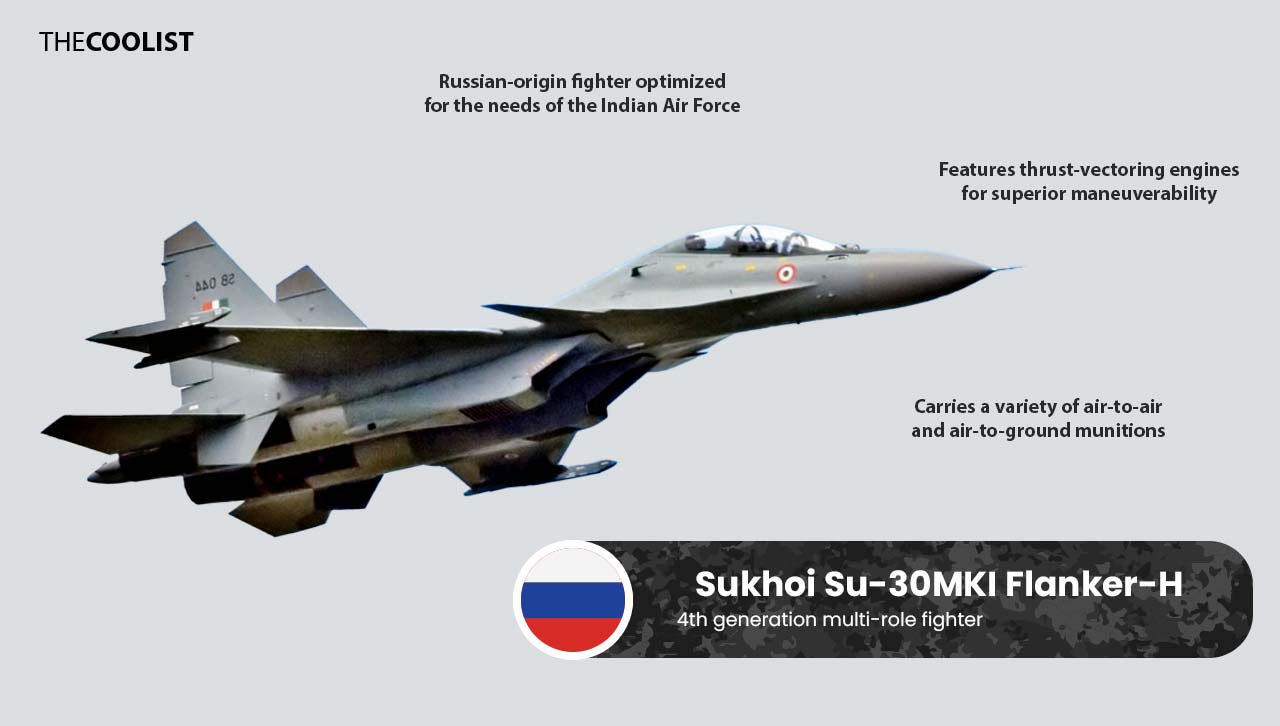
The Sukhoi Su-30MKI Flanker-H has an empty weight of 39,020 lb (17,700 kg), a length of 72.2 ft (22 m), a wingspan of 48.2 ft (14.7 m), and a height of 20.3 ft (6.2 m). The below table offers insight into the technical specifications of the Sukhoi Su-30MKI Flanker-H.
| Metric | Sukhoi Su-30MKI Flanker-H |
| Speed | Mach 2 / 1,333 knots |
| Range (combat/max) | 1,080 NM / 1,930 NM |
| Service Ceiling | 58,000 ft (17,700 m) |
| Turn Rate | Not publicly disclosed |
| Turn Radius | Not publicly disclosed |
| Radar Cross Section | Not publicly disclosed |
| Armament | R-77, R-27, R-73 air-to-air missiles, Kh-31P, Kh-29L air-to-ground missiles, BrahMos cruise missile, 30mm GSh-30-1 cannon, etc. |
| Multirole | Yes (Air-to-air combat, ground attack, anti-ship, etc.) |
| TtW (Thrust-to-Weight Ratio) | Approximately 0.98 |
| Endurance | Not publicly disclosed; capability enhanced with mid-air refueling |
| Survivability | High (advanced avionics, electronic countermeasures, IRST system) |
| Thrust Vectoring | Yes (2D) |
The next best fighter jet, the Panavia Tornado, stands out for its variable-sweep wing design and its specialization in low-altitude penetration for strike missions. In contrast, the Sukhoi Su-30MKI has superior air combat maneuverability, long-range capability, and a more diverse set of roles, including air-to-air and air-to-ground missions.
19. Panavia Tornado (Multi-national) – 4th generation multirole fighter
The Panavia Tornado is a twin-engine, variable-sweep wing multirole combat aircraft. The Tornado was developed by the Panavia Aircraft GmbH consortium, which included British Aerospace, MBB of Germany, and Aeritalia of Italy. The Tornado first flew on August 14, 1974, entered military service in 1979, and retired in 2011 when the Eurofighter Typhoon replaced it. The aircraft’s ability to rapidly adjust its wing sweep angle gave it unparalleled versatility, allowing for optimal performance across various mission profiles. This design characteristic made it one of the finest fighter jets of the later Cold War and post-Cold War eras.
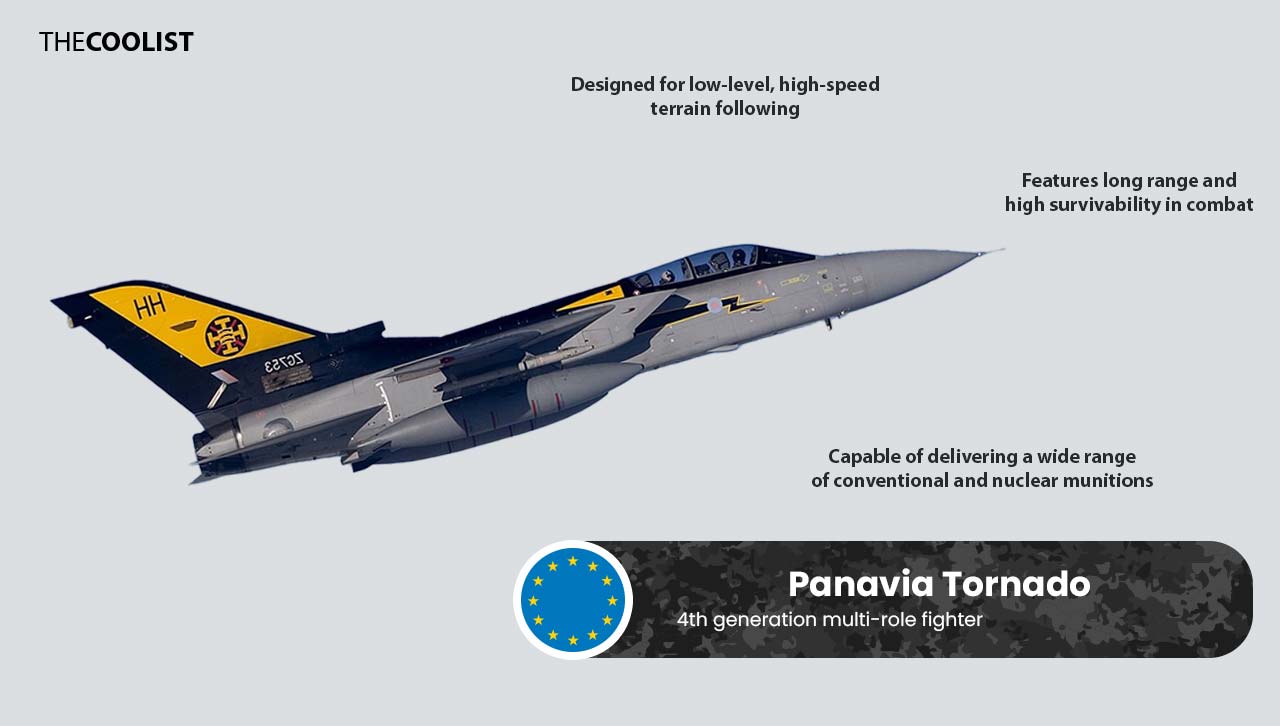
The Tornado was designed to meet the diverse requirements of Germany, Italy, and the UK. Consequently, the Tornado came in three primary variants: air defense, interdictor/strike, and electronic combat/reconnaissance.
The Panavia Tornado has an empty weight of 31,620 lb (14,350 kg), a length of 54.5 ft (16.6 m), a wingspan ranging from 28.2 ft (8.6 m) with wings fully swept back to 45.6 ft (13.9 m) when spread, and a height of 19.6 ft (6 m). The table below dives into the technical specifications of the Panavia Tornado.
| Metric | Panavia Tornado |
| Speed | Mach 2.2 / 1,452 knots |
| Range (combat/max) | 390 NM / 2,417 NM |
| Service Ceiling | 50,000 ft (15,240 m) |
| Turn Rate | Not publicly disclosed |
| Turn Radius | Not publicly disclosed |
| Radar Cross Section | Not publicly disclosed |
| Armament | AIM-9 Sidewinder, AIM-132 ASRAAM, AGM-65 Maverick, ALARM anti-radar missile, 27mm Mauser BK-27 cannon, various bombs, etc. |
| Multirole | Yes (Ground attack, air defense, reconnaissance, SEAD) |
| TtW (Thrust-to-Weight Ratio) | Approximately 0.96 |
| Endurance | Not publicly disclosed; capability enhanced with external fuel tanks |
| Survivability | High (advanced avionics, electronic countermeasures) |
| Thrust Vectoring | No |
The next best fighter jet, the Lockheed Martin F-117 Nighthawk, is distinguished by its pioneering stealth technology and focus on ground attack. The F-117 is particularly designed for high-value, precision-targeted strikes under the cover of night. In contrast, the Panavia Tornado has optimized performance across different flight regimes, and excels in its role in low-altitude, high-speed penetration bombing.
20. Lockheed Martin F-117 Nighthawk (USA) – 1st generation stealth attack aircraft
The Lockheed Martin F-117 Nighthawk is a single-engine, twin-tailed stealth attack aircraft. Lockheed’s Skunk Works division developed the F-117, with senior engineer Alan Brown making the most significant contributions. The Nighthawk was designed with a unique faceted appearance that deflected radar signals, allowing the jet to penetrate dense anti-aircraft defenses and strike high-value targets with precision. The F-117 first took flight on June 18, 1981, and became the world’s first operational stealth warplane upon its entry into service in 1983. However, the existence of the F-117 wasn’t publicly acknowledged until 1988.
The F-117 played a pivotal role in conflicts like the Gulf War and its groundbreaking design paved the way for subsequent stealth aircraft and demonstrated the U.S. military’s commitment to achieving air superiority. The F-117 remains one of the most iconic fighter jets to this day, despite retiring in 2008 after a 35-year career.
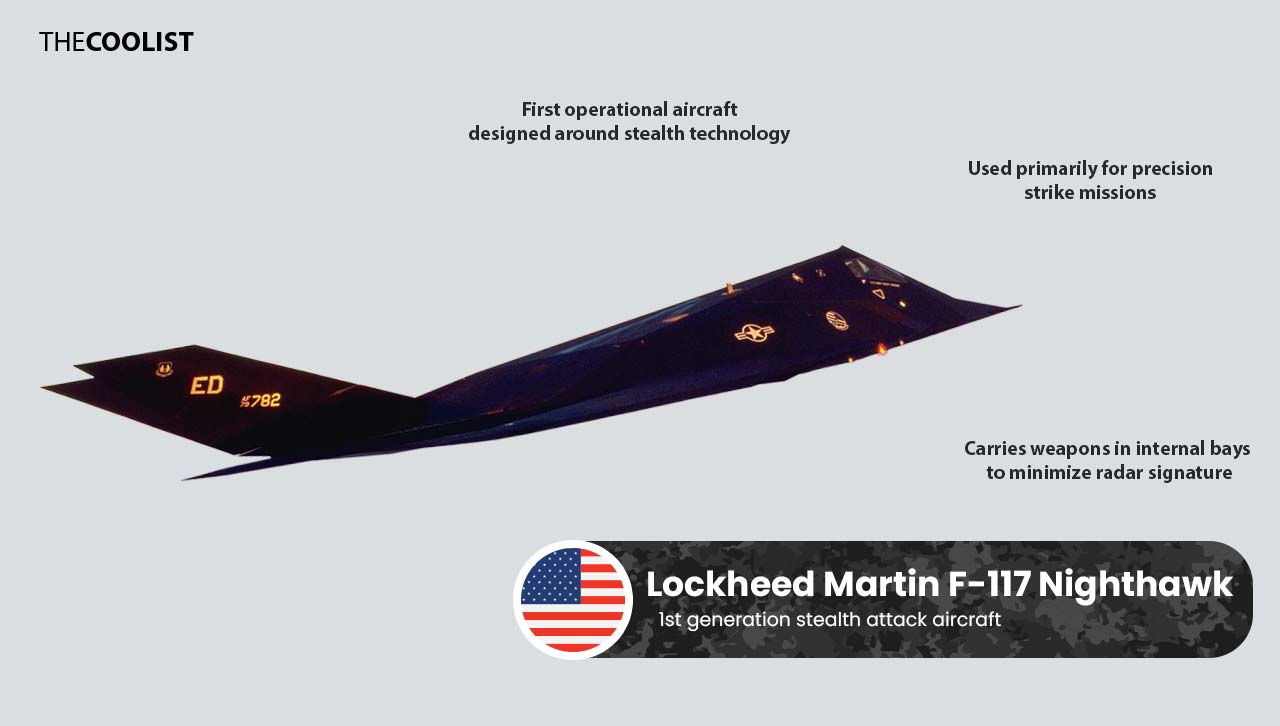
The F-117 Nighthawk has an empty weight of approximately 29,500 lb (13,380 kg), a length of 65.9 ft (20.1 m), a wingspan of 43.4 ft (13.2 m), and a height of 12.5 ft (3.8 m). The F-117 has an engineered edge in covert operations thanks to its distinctive angular shape, which was meticulously crafted to minimize radar visibility.
Below is a table that shows a detailed breakdown of the Lockheed Martin F-117 Nighthawk specifications.
| Metric | Lockheed Martin F-117 Nighthawk |
| Speed | 0.92 / 720 knots |
| Range (combat/max) | 930 NM |
| Service Ceiling | 45,000 ft (13,700 m) |
| Turn Rate | Not publicly disclosed |
| Turn Radius | Not publicly disclosed |
| Radar Cross Section | Extremely low due to stealth design |
| Armament | GBU-10, GBU-12, GBU-27 laser-guided bombs |
| Multirole | No (primarily ground attack) |
| TtW (Thrust-to-Weight Ratio) | Not publicly disclosed |
| Endurance | Not publicly disclosed |
| Survivability | High (advanced stealth technology) |
| Thrust Vectoring | No |
The next best fighter, the Northrop F-5 Freedom Fighter/Tiger II, is known for its simplicity, ease of maintenance, and effectiveness in air-to-air combat and light ground-attack roles. In contrast, the Lockheed Martin F-117 Nighthawk specializes in stealth technology for covert operations, focusing on precision-targeted, ground-attack missions under stealth cover.
21. Northrop F-5 Freedom Fighter/Tiger II (USA) – 3rd generation light fighter
The Northrop F-5 Freedom Fighter/Tiger II is a supersonic, twin-engine, lightweight fighter aircraft designed by Edgar Schmued and the Northrop Corporation. Schmued designed the F-5 as a cost-effective, easy-to-maintain combat jet suitable for a broad range of missions. The Tiger II is highly agile despite its modest size and cost, making it an effective air-to-air combatant. The Northrop F-5 Freedom Fighter/Tiger II is celebrated as one of the best jet fighters in the world due to its balance of performance, ease of maintenance, low operational costs, and adaptability in various combat roles and training missions.
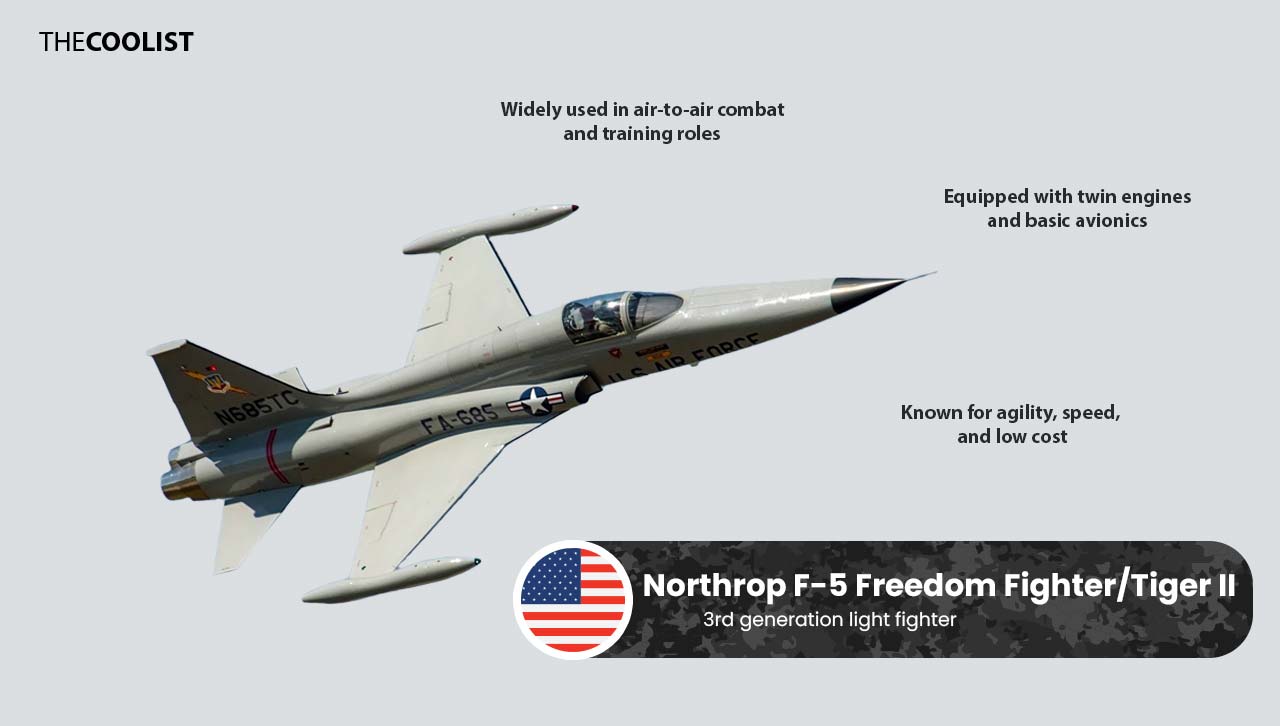
The F-5 Freedom Fighter took its maiden flight on July 30, 1959, before entering service in 1962, and has yet to retire. The F-5’s continued service half a century after its maiden flight is a testament to its exceptional prowess.
The Northrop F-5 Freedom Fighter/Tiger II weighs approximately 9,725 lb (4,410 kg) when empty. The jet boasts a length of 47.4 ft (14.45 m), a wingspan of 26.8 ft (8.13 m), and a height of 13.4 ft (4.08 m).
The below table offers a more detailed breakdown of the Northrop F-5 FreedomFighter / Tiger II.
| Metric | Northrop F-5 Freedom Fighter/Tiger II |
| Speed | Mach 1.6 / 1,060 knots |
| Range (combat/max) | 760 NM / 2,010 NM |
| Service Ceiling | 51,800 ft (15,800 m) |
| Turn Rate | Not publicly disclosed |
| Turn Radius | Not publicly disclosed |
| Radar Cross Section | Not publicly disclosed |
| Armament | AIM-9 Sidewinder, AIM-120 AMRAAM, AGM-65 Maverick, 20mm M39A2 cannon, various bombs, etc. |
| Multirole | Yes (Ground attack, air-to-air combat, training) |
| TtW (Thrust-to-Weight Ratio) | Approximately 0.93 |
| Endurance | Not publicly disclosed |
| Survivability | Medium (given its age and limited electronic countermeasures) |
| Thrust Vectoring | No |
The next best fighter jet, the Mikoyan MiG-21, is recognized for its high speed, agility, and role as one of the most prolific supersonic jet fighters, with a primary focus on air-to-air combat. In comparison, the Northrop F-5 Freedom Fighter is lauded for its simplicity, cost-effectiveness, and versatility in both air-to-air engagements and light ground-attack missions.
22. Mikoyan MiG-21 Fishbed (Russia) – 3rd generation interceptor/fighter
The Mikoyan MiG-21 Fishbed is a single-engine, supersonic jet fighter designed by Artem Ivanovich Mikoyan, co-founder of the Soviet Union’s Mikoyan Design Bureau. The simplicity of the jet’s design, along with its robustness and agility have earned the MiG-21 its reputation as one of the best fighter jets of the Cold War era. The MiG-21 Fishbed additionally became one of the most produced jet fighters in history.

The MiG-21 entered active service in 1960 as a frontline aircraft for the Soviet Air Force and its allies during the Cold War. The MiG-21 has seen combat in conflicts worldwide, serving in various roles from interceptor to ground attack. The MiG-21’s combat successes have earned the jet a reputation for its performance and adaptability.
The Mikoyan MiG-21 Fishbed has an empty weight of approximately 11,464 lb (5,200 kg). It features a length of 51.8 ft (15.8 m), a wingspan of 23.5 ft (7.15 m), and a height of 15.3 ft (4.65 m). The MiG-21’s delta wing configuration emphasizes the aircraft’s focus on speed and maneuverability.
The below table lists the key tech specs relating to the Mikoyan MiG-21.
| Metric | Mikoyan MiG-21 Fishbed |
| Speed | Mach 2 / 1,333 knots |
| Range (combat/max) | 288 NM / 1,158 NM |
| Service Ceiling | 58,400 ft (17,800 m) |
| Turn Rate | Not publicly disclosed |
| Turn Radius | Not publicly disclosed |
| Radar Cross Section | Not publicly disclosed |
| Armament | R-13, R-3S, R-60 air-to-air missiles, various bombs, 23mm GSh-23L cannon, etc. |
| Multirole | No (primarily air-to-air combat; later variants had limited ground attack capability) |
| TtW (Thrust-to-Weight Ratio) | Approximately 0.88 |
| Endurance | Not publicly disclosed |
| Survivability | Medium (limited electronic countermeasures; simple design) |
| Thrust Vectoring | No |
The next best fighter jet, the F-4 Phantom II, is notable for its versatility, high speed, large payload capacity, and performance in both air superiority and ground-attack roles. In contrast, the Mikoyan MiG-21 focuses on high speed and agility, serving primarily as a supersonic jet fighter in air-to-air combat.
23. McDonnell Douglas F-4 Phantom II (USA) – 3rd generation multirole fighter
The McDonnell Douglas F-4 Phantom II is a tandem two-seat, twin-engine, all-weather, long-range supersonic jet interceptor and fighter-bomber. The F-4 was designed and manufactured by McDonnell Aircraft (which later merged with Douglas to form McDonnell Douglas) under the direction of Herman Barkey. The Phantom II recorded its first flight on May 27, 1958. The jet’s powerful engines, advanced radar, and large payload capacity helped it beat numerous performance records and gain acclaim as one of the world’s finest fighter jets.
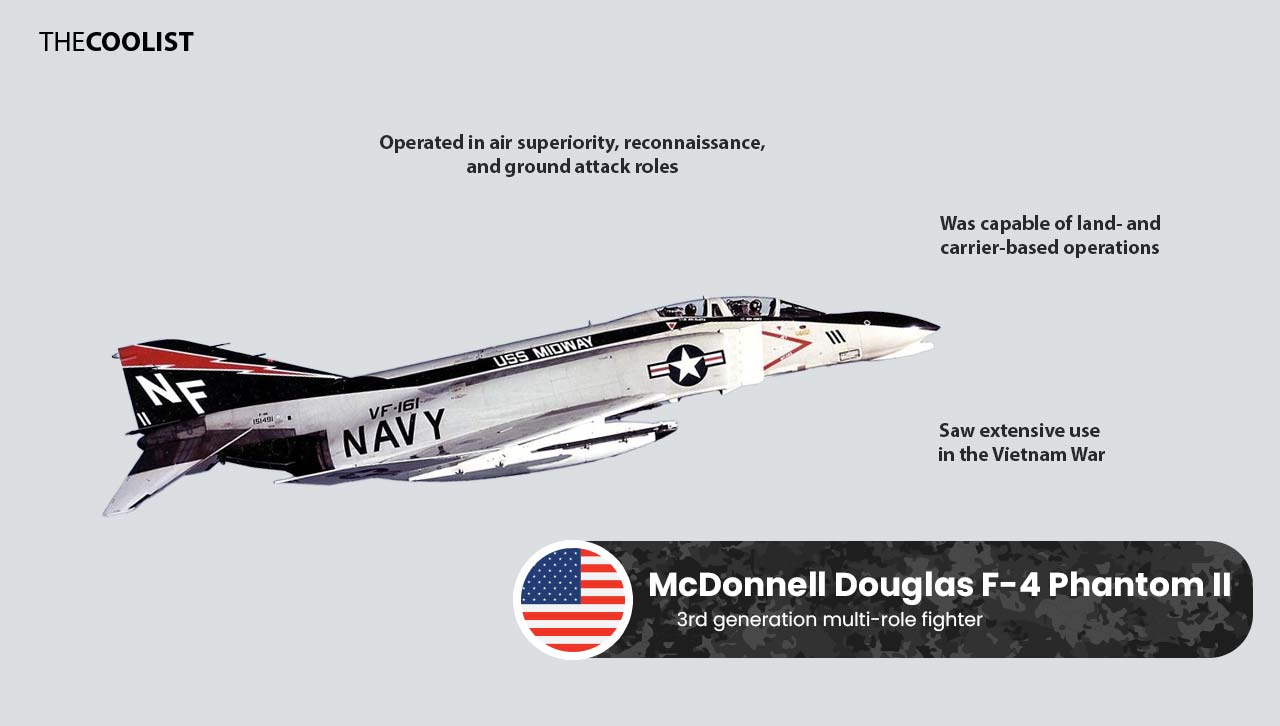
The F-4 was initially designed to meet the U.S. Navy’s needs. However, the jet’s entry into service in 1961 highlighted its versatility and exceptional performance, so the F-4 was soon adopted by the U.S. Marine Corps and the USAF. There, the jet played a crucial role during the Vietnam War.
The McDonnell Douglas F-4 Phantom II boasts an empty weight of approximately 28,000 lb (12,700 kg), a length of 63 ft (19.2 m), a wingspan of 38.5 ft (11.7 m), and a height of 16.5 ft (5.0 m). The below table shows detailed specifications for the McDonnell Douglas F-4 Phantom II.
| Metric | McDonnell Douglas F-4 Phantom II |
| Speed | Mach 2.23 / 1,473 knots |
| Range (combat/max) | 367 NM / 1,381 NM with drop tanks |
| Service Ceiling | 60,000 ft (18,300 m) |
| Turn Rate | Not publicly disclosed |
| Turn Radius | Not publicly disclosed |
| Radar Cross Section | Not publicly disclosed |
| Armament | AIM-7 Sparrow, AIM-9 Sidewinder, AGM-65 Maverick, various bombs, 20mm M61A1 Vulcan cannon, etc. |
| Multirole | Yes (Air-to-air combat, ground attack, reconnaissance) |
| TtW (Thrust-to-Weight Ratio) | Approximately 0.86 |
| Endurance | Not publicly disclosed; capability enhanced with external fuel tanks |
| Survivability | High (advanced avionics for its time, electronic countermeasures) |
| Thrust Vectoring | No |
The next best aircraft, the BAE Systems Hawk, is primarily used as an advanced jet trainer with capabilities for light attack roles. In contrast, the F-4 Phantom II is a multirole interceptor and fighter-bomber, renowned for its high speed, large payload, and versatility across a wide range of missions.
24. BAE Systems Hawk (UK) – jet trainer and light attack aircraft
The BAE Systems Hawk is a single-engine, advanced jet trainer developed by the British company BAE Systems as a training aircraft for pilots transitioning to front-line jet fighters. The Hawk entered military service in 1976 after a successful first flight on August 21, 1974. The Hawk soon proved its worthiness as a trainer and in light combat roles. BAE Systems Hawk is a widely recognizable aircraft and is resoundingly judged to be one of the best fighters in the world.
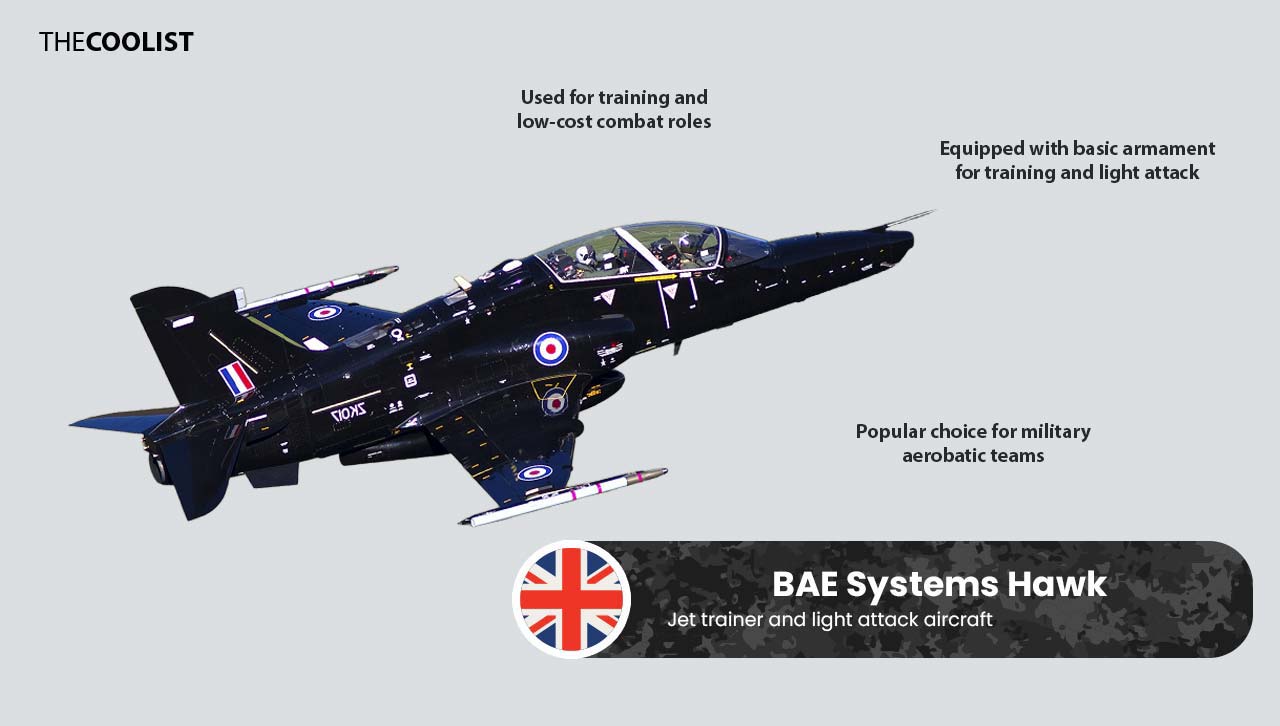
The Hawk’s agile performance, reliability, and cost-effectiveness made it a preferred choice for air forces worldwide. Notably, the Red Arrows (the aerobatic team of the Royal Air Force) have adopted the Hawk as their signature aircraft and have showcased its capabilities in numerous airshows.
The BAE Systems Hawk has an empty weight of approximately 9,880 lb (4,480 kg). In terms of its design specifications, the aircraft measures a length of 39.4 ft (12.0 m), has a wingspan of 31.4 ft (9.6 m), and stands with a height of 13.3 ft (4.0 m). Through its blend of efficiency and versatility, the Hawk solidifies its position as a cornerstone in the realm of military training aircraft.
The table below provides a deep dive into the technical side of the BAE Systems Hawk.
| Metric | BAE Systems Hawk |
| Speed | Mach 0.84 / 658 knots |
| Range (combat/max) | 345 NM / 1,000 NM |
| Service Ceiling | 44,500 ft (13,600 m) |
| Turn Rate | Not publicly disclosed |
| Turn Radius | Not publicly disclosed |
| Radar Cross Section | Not publicly disclosed |
| Armament | AIM-9 Sidewinder, AGM-65 Maverick, CRV7 rockets, various bombs, 30mm ADEN cannon (on some versions), etc. |
| Multirole | Primarily a trainer aircraft; some versions are equipped for light ground attack roles |
| TtW (Thrust-to-Weight Ratio) | Not publicly disclosed |
| Endurance | Not publicly disclosed; capability enhanced with external fuel tanks |
| Survivability | Medium (limited electronic countermeasures, mainly reliant on training and tactics) |
| Thrust Vectoring | No |
The next best fighter jet, the Su-27, excels with its exceptional maneuverability, long range, heavy armament, and is primarily designed for air superiority roles. In contrast, the BAE Systems Hawk is more focused on training and light attack missions.
25. Sukhoi Su-27 Flanker (Russia) – 4th generation air superiority fighter
The Sukhoi Su-27 Flanker is a twin-engine, supermaneuverable fighter aircraft developed by Russia’s Sukhoi Design Bureau, with Mikhail Simonov as the lead designer. Its distinctive blend of size, agility, and firepower characterized the Su-27 and made it one of the top fighter jets in the world. The fighter entered active service in 1985 where it served as a direct competitor to the U.S.’s fourth-generation fighters, particularly the F-15 Eagle.
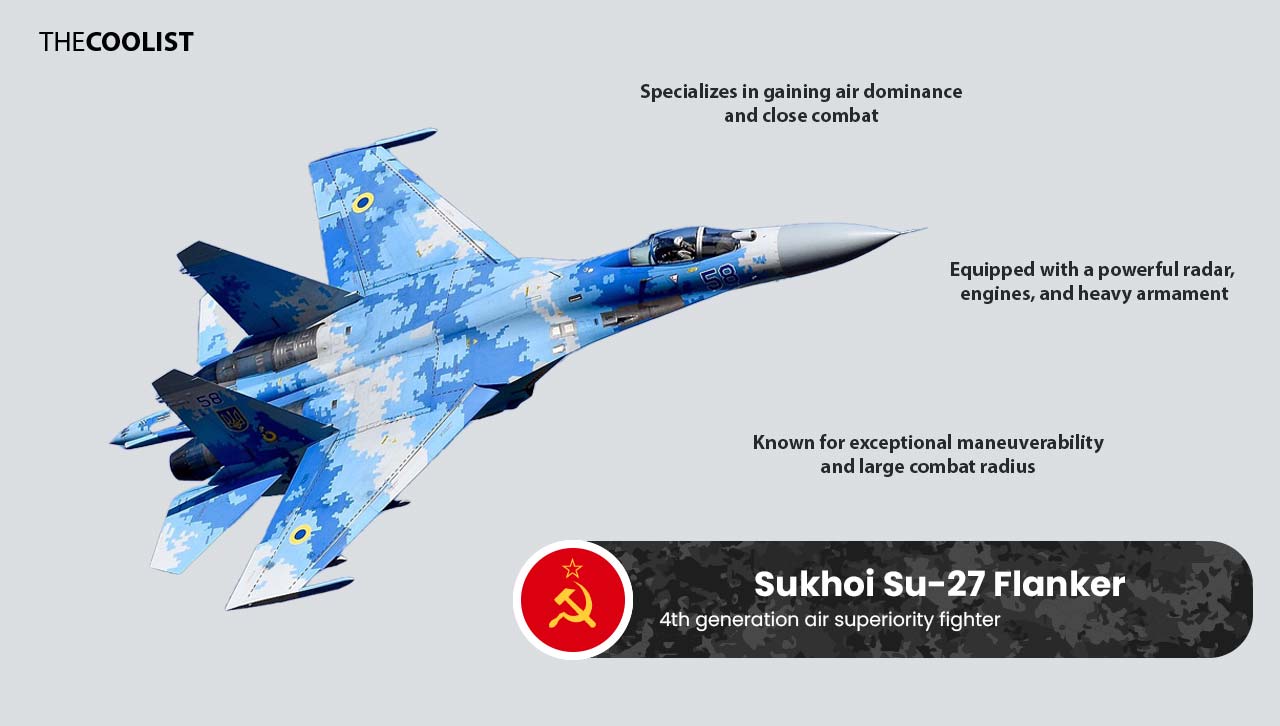
The Su-27 became a pivotal aircraft for the Soviet Air Force and its successors. Designed primarily for air superiority missions, the Su-27’s capabilities later expanded to include multirole functions, thanks to its impressive range, large payload capacity, and advanced avionics.
The Sukhoi Su-27 Flanker has an empty weight of approximately 37,500 lb (17,000 kg). Its design outlines a length of 72.9 ft (22.2 m), a wingspan of 48.2 ft (14.7 m), and a height of 19.4 ft (5.9 m). The Flanker offers a unique combination of power and agility and stands as a testament to Russia’s prowess in jet fighter development.
Below is a table that offers a more data-driven view of the Sukhoi Su-27 flanker.
| Metric | Sukhoi Su-27 Flanker |
| Speed | Mach 2.35 / 1,567 knots |
| Range (combat/max) | 750 NM / 2,160 NM |
| Service Ceiling | 62,523 ft (19,000 m) |
| Turn Rate | Not publicly disclosed |
| Turn Radius | Not publicly disclosed |
| Radar Cross Section | Not publicly disclosed |
| Armament | R-73, R-77, R-27 air-to-air missiles, various bombs, 30mm GSh-30-1 cannon, etc. |
| Multirole | Yes (Air-to-air combat, ground attack) |
| TtW (Thrust-to-Weight Ratio) | Approximately 1.07 |
| Endurance | Not publicly disclosed |
| Survivability | High (advanced avionics, electronic countermeasures, and aerodynamic design) |
| Thrust Vectoring | No |
The next best fighter jet, the MiG-23, stands out with its variable-geometry wings and its role as both an interceptor and ground-attack aircraft. In contrast, the Su-27 is recognized for its maneuverability, longer range, and emphasis on air superiority.
26. Mikoyan MiG-23 Flogger (Russia) – 3rd generation swing-wing fighter
The Mikoyan MiG-23 Flogger is a variable-geometry wing, single-engine fighter aircraft developed by the Soviet Union’s Mikoyan Design Bureau. The MiG-23 stands as one of the best fighter jets in the world for its variable-geometry wings and high-speed intercept capabilities. A versatile and potent fighter in various air combat scenarios.
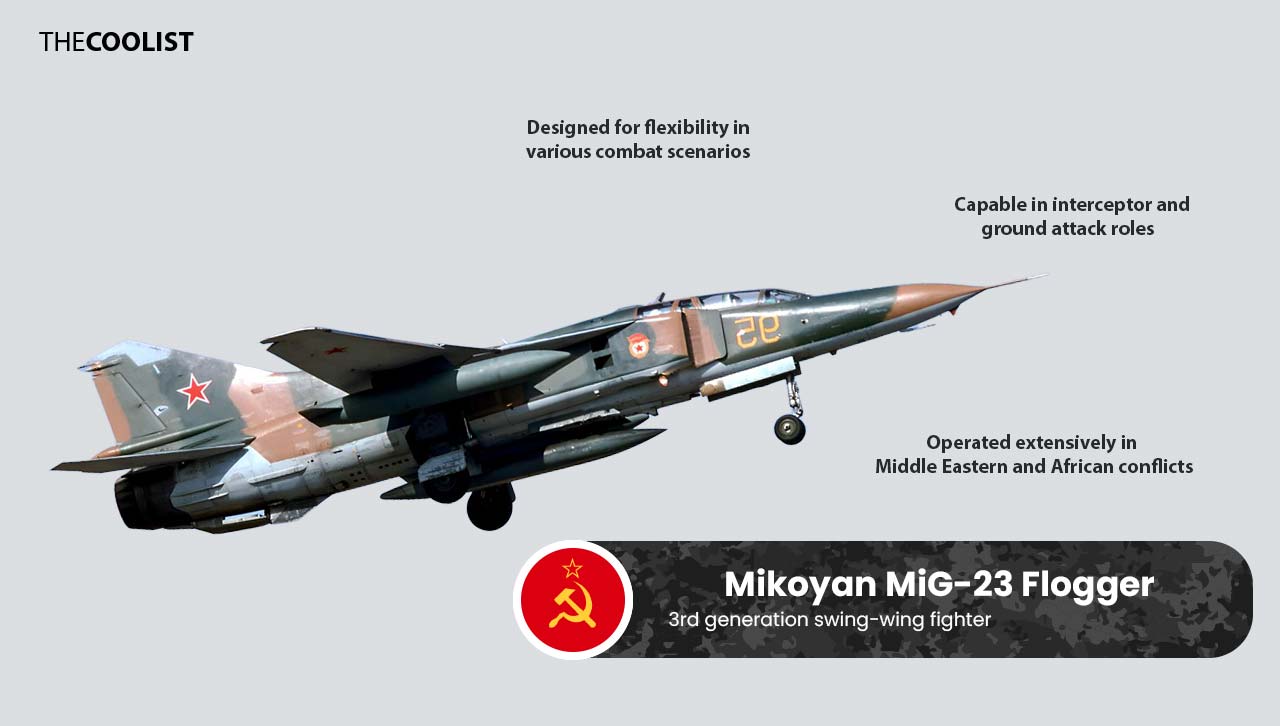
After passing its first flight on June 10, 1967, the MiG-23 entered active service in 1970. The MiG-23 Flogger was designed to replace the MiG-21 as the Soviet Air Force’s primary interceptor and swiftly gained recognition as one of the world’s leading fighter jets. The Floggers’ most distinguishing feature is its swing-wing design, which allows the wings to be swept back or spread out to optimize performance at different speeds.
The Mikoyan MiG-23 Flogger has an operational empty weight of approximately 21,495 lb (9,750 kg). Its design metrics include a length of 54.5 ft (16.6 m), a wingspan varying from 27.5 ft (8.4 m) when fully swept to 45.9 ft (14.0 m) when spread, and a height of 16 ft (4.8 m). The MiG-23’s adaptability across a range of operational scenarios serves as a reflection of Soviet engineering and innovation during its era.
The table below offers a more nuanced look at the Mikoyan MiG-23 Flogger.
| Metric | Mikoyan MiG-23 Flogger |
| Speed | Mach 2.35 / 1,567 knots |
| Range (combat/max) | 683 NM / 1,160 NM |
| Service Ceiling | 60,695 ft (18,500 m) |
| Turn Rate | Not publicly disclosed |
| Turn Radius | Not publicly disclosed |
| Radar Cross Section | Not publicly disclosed |
| Armament | R-23, R-60 air-to-air missiles, various bombs, 23mm GSh-23L cannon, etc. |
| Multirole | Primarily air-to-air combat; some versions equipped for ground attack |
| TtW (Thrust-to-Weight Ratio) | Not publicly disclosed |
| Endurance | Not publicly disclosed |
| Survivability | Medium (given its age and limited electronic countermeasures) |
| Thrust Vectoring | No |
The next best fighter jet, the AIDC F-CK-1 Ching-kuo, integrates advanced avionics and electronic warfare systems suited for its regional defense role. In comparison, the MiG-23’s distinctive variable-geometry wings are designed for flexibility in both air-to-air and air-to-ground missions, and its focus is on being an effective interceptor and ground-attack fighter.
27. AIDC F-CK-1 Ching-kuo (Taiwan) – 4th generation multirole fighter
The AIDC F-CK-1 Ching-kuo is a twin-engine, multi-role fighter aircraft developed by Taiwan’s Aerospace Industrial Development Corporation (AIDC). The AIDC F-CK-1 Ching-kuo is one of the most formidable fighter jets in the world due to its advanced avionics and agile performance. The aircraft’s indigenous Taiwanese design, which caters specifically to the defense needs of the Republic of China Air Force, has earned it the nickname “Indigenous Defense Fighter”.
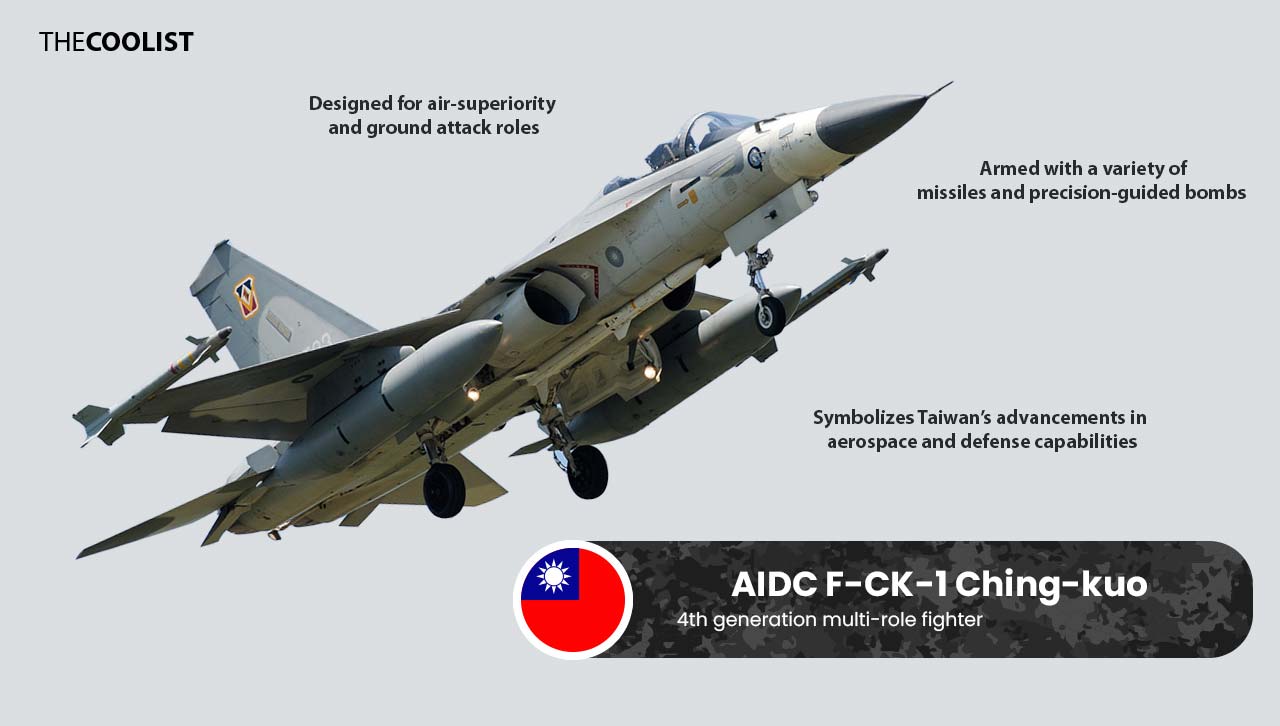
The Ching-kuo was born from Taiwan’s need for a modern fighter in the face of arms embargoes and its maiden flight took place on May 28, 1989. The aircraft was designed for both air-to-air and air-to-ground missions and combines modern avionics, versatile weapon systems, and a nimble airframe. The development and deployment of the F-CK-1 underscore Taiwan’s drive to maintain a robust self-defense capability in the region.
The AIDC F-CK-1 Ching-kuo has an empty weight of 14,991 lb (6,800 kg). The fighter’s architectural dimensions include a length of 46.6 ft (14.2 m), a wingspan of 28.2 ft (8.6 m), and a height of 15.1 ft (4.6 m). Below is a more in-depth overview of the Ching-kuo’s specifications and performance.
| Metric | AIDC F-CK-1 Ching-kuo |
| Speed | Mach 2 / 1,333 knots |
| Range (combat/max) | 500 NM / 1,100 NM |
| Service Ceiling | 55,000 ft (16,800 m) |
| Turn Rate | Not publicly disclosed |
| Turn Radius | Not publicly disclosed |
| Radar Cross Section | Not publicly disclosed |
| Armament | TC-1, TC-2 air-to-air missiles, Wan Chien cruise missiles, 20mm M61A1 Vulcan cannon, various bombs, etc. |
| Multirole | Yes (Air-to-air combat, ground attack) |
| TtW (Thrust-to-Weight Ratio) | Approximately 0.91 |
| Endurance | Not publicly disclosed |
| Survivability | Medium (modern avionics, but lacks advanced stealth features) |
| Thrust Vectoring | No |
The next best fighter jet, the Su-24, is a supersonic, all-weather attack aircraft known for its low-level, high-speed penetration capability and large payload, especially designed for ground attacks. In comparison, the AIDC F-CK-1 Ching-kuo emphasizes multirole flexibility, advanced avionics, and electronic warfare, tailored more for air defense and tactical missions than for the specialized, deep strike role of the Su-24.
28. Sukhoi Su-24 Fencer (Russia) – 4th generation all-weather attack aircraft
The Sukhoi Su-24 Fencer is a twin-engine, all-weather supersonic strike aircraft developed by the USSR’s Sukhoi Design Bureau to replace aging bombers and entered service in 1974. The Su-24 is considered one of the best jet fighters because of its renowned all-weather, low-level attack capabilities.
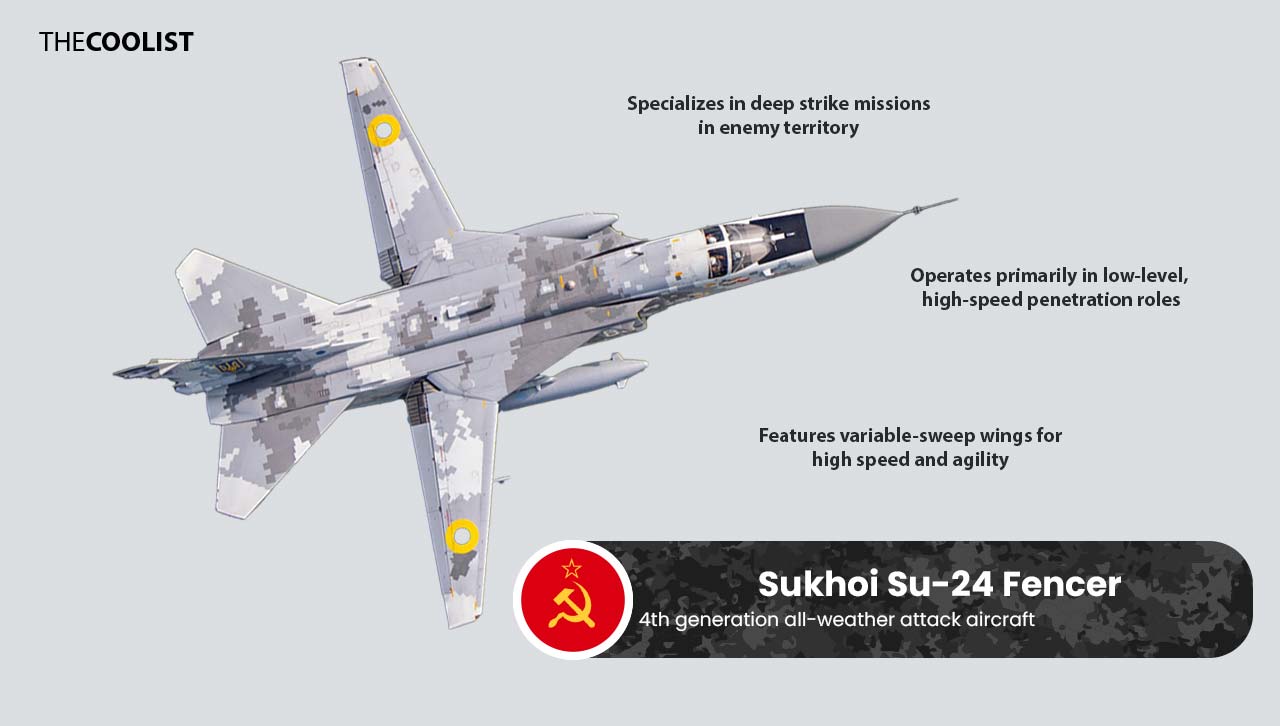
The Fencer is equipped with variable-sweep wings, which give the jet agility when executing low-level penetrations of enemy defenses or delivering precision strikes in challenging conditions. The fighter’s versatile airframe and sophisticated avionics enable it to conduct deep strike missions, reconnaissance, and maritime operations. The Su-24 has undergone modernization over the years and remains a crucial asset in various air forces.
The Sukhoi Su-24 Fencer has an empty weight of approximately 48,500 lb (22,000 kg). The fighter sports a length of 73.6 ft (22.4 m), a wingspan varying from 34.4 ft (10.5 m) when wings are swept back to 57.7 ft (17.6 m) when extended, and a height of 20.7 ft (6.3 m). These dimensions, coupled with the Su-24’s advanced electronics and powerful engines, emphasize the aircraft’s dominance in strike and interdiction roles. The performance and specifications of the Fencer are summarized in the table below.
| Metric | Sukhoi Su-24 Fencer |
| Speed | Mach 1.35 / 900 knots |
| Range (combat/max) | 615 NM / 1,553 NM |
| Service Ceiling | 57,415 ft (17,500 m) |
| Turn Rate | Not publicly disclosed |
| Turn Radius | Not publicly disclosed |
| Radar Cross Section | Not publicly disclosed |
| Armament | R-60, Kh-23, Kh-25, Kh-29 air-to-surface missiles, various bombs, 23mm GSh-6-23M cannon, etc. |
| Multirole | Primarily a ground-attack aircraft |
| TtW (Thrust-to-Weight Ratio) | Not publicly disclosed |
| Endurance | Not publicly disclosed |
| Survivability | Medium (given its age, but equipped with electronic countermeasures) |
| Thrust Vectoring | No |
The next best fighter jet, the F-104 Starfighter was celebrated for its exceptional straight-line speed and high-altitude performance and served in interceptor and air-superiority roles. In contrast, the Su-24’s focus is on low-level, high-speed penetration for ground attacks.
29. Lockheed F-104 Starfighter (USA) – 2nd generation interceptor/fighter
The Lockheed F-104 Starfighter is a single-engine, supersonic interceptor aircraft that was developed by Lockheed Corporation under the leadership of Clarence “Kelly” Johnson. The F-104 entered service in 1958 and gained acclaim for its exceptional speed, climb rate, and high-altitude performance.

The F-104 was a product of the Cold War era, during which the USAF needed a high-speed, high-altitude interceptor. The F-104’s slender fuselage, stubby wings, and distinct T-tail characterized its design and gave the plane its high speed and climb performance, eventually earning it the “missile with a man in it” moniker. However, the Starfighter’s demanding flight characteristics earned it a reputation as a challenging aircraft to pilot. The F-104 found a place in numerous air forces around the world and saw action in several conflicts despite the complexities associated with its operation.
The Lockheed F-104 Starfighter has an empty weight of approximately 14,000 lb (6,350 kg), a length of 54.8 ft (16.7 m), a wingspan of 21.9 ft (6.7 m), and a height of 13.5 ft (4.1 m). These specifications highlight the Starfighter’s emphasis on speed and agility, tailored to achieve rapid intercepts and deliver quick strikes. The table below provides a summary of the F-104’s specifications and performance.
| Metric | Lockheed F-104 Starfighter |
| Speed | Mach 2 / 1,333 knots |
| Range (combat/max) | 420 NM / 1,630 NM |
| Service Ceiling | 50,000 ft (15,240 m) |
| Turn Rate | Not publicly disclosed |
| Turn Radius | Not publicly disclosed |
| Radar Cross Section | Not publicly disclosed |
| Armament | AIM-9 Sidewinder, M61A1 Vulcan 20mm cannon, various bombs and rockets |
| Multirole | No; primarily an interceptor |
| TtW (Thrust-to-Weight Ratio) | Not publicly disclosed |
| Endurance | Not publicly disclosed |
| Survivability | Low to Medium (given its age and limited electronic countermeasures) |
| Thrust Vectoring | No |
The next top jet fighter, the Dassault Mirage 2000, is known for its delta wing design, which contributed to its high-speed performance and agility. In comparison, the F-104 Starfighter’s focus was on straight-line speed and high-altitude interception.
30. Dassault Mirage 2000 (France) – 4th generation multirole fighter
The Dassault Mirage 2000 is a single-engine, multi-role fighter aircraft developed by the French aerospace company Dassault Aviation. The Dassault Mirage 2000 is one of the most formidable multi-role fighter jets due to its versatility, proven combat track record, and advanced avionics.
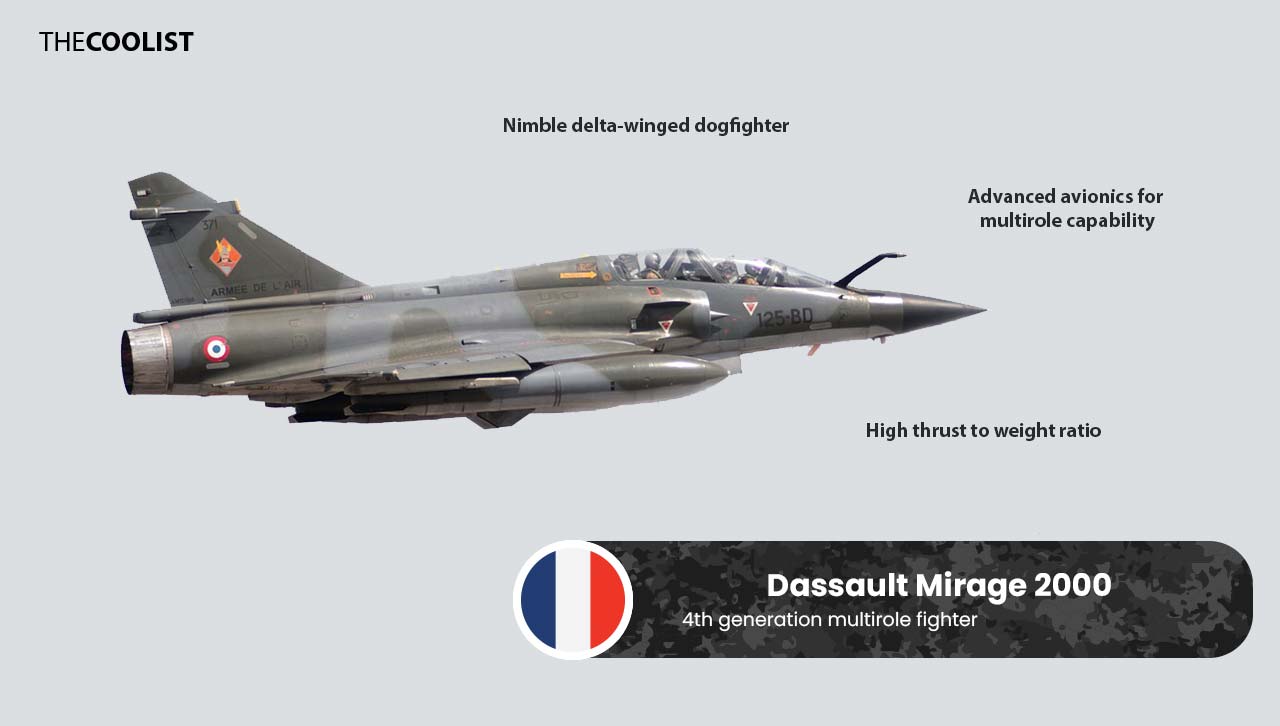
The Mirage 2000 was conceived as a modern successor to the earlier Mirage III that entered service in the French Air Force in 1984. The aircraft’s sleek delta-wing design and advanced avionics quickly made it a staple for aerial combat, reconnaissance, and nuclear deterrence roles. Various nations have purchased the Mirage 2000 over the years.
The Dassault Mirage 2000 has an empty weight of approximately 16,500 lb (7,500 kg), a length of 47.6 ft (14.5 m), a wingspan of 29.7 ft (9.1 m), and a height of 17.4 ft (5.3 m). These specifications, along with the jet’s powerful engine and nimble airframe give it superior performance to dominate in dogfighting and strike missions. The table below provides an overview of the Dassault Mirage 2000 specifications and performance.
| Metric | Dassault Mirage 2000 |
| Speed | Mach 2.2 / ~1,452 knots |
| Range (combat/max) | 550 NM / 1,150 NM |
| Service Ceiling | 59,000 ft (18,000 m) |
| Turn Rate | Not publicly disclosed |
| Turn Radius | Not publicly disclosed |
| Radar Cross Section | Not publicly disclosed |
| Armament | Magic II, MICA IR/RF, Exocet, AS-30L, various bombs, 30mm DEFA 554 cannon, etc. |
| Multirole | Yes (Air-to-air combat, ground attack, reconnaissance, and more) |
| TtW (Thrust-to-Weight Ratio) | Approximately 0.91 |
| Endurance | Not publicly disclosed |
| Survivability | Medium to High (modern avionics and electronic countermeasures) |
| Thrust Vectoring | No |
What are the best US jet fighters?
The best US jet fighters are listed below.
- Lockheed Martin F-35 Lightning II: Entered service in 2015 as a multirole stealth fighter. It hits speeds of up to Mach 1.6 (1,200 mph, 1,930 km/h) and has a range of 1,200 miles (1,930 km). The F-35 is armed with a combination of AIM-120 AMRAAM, AIM-9X Sidewinder, and internal 25mm cannon, along with the capability to carry air-to-ground ordnance.
- Lockheed Martin F-22 Raptor: The F-22 is an air superiority stealth fighter that entered service in 2015. It reaches speeds of Mach 2.25 (1,500 mph, 2,410 km/h) and has a range of 1,840 miles (2,960 km) with drop tanks. Its armament includes AIM-120 AMRAAM, AIM-9 Sidewinder, and an internal 20mm M61A2 cannon.
- Boeing F/A-18 Super Hornet: The F/A-18 began its service in 1999 and is a multirole fighter/attack aircraft. It boasts speeds up to Mach 1.8 (1,190 mph, 1,915 km/h) and a range of 1,275 miles (2,050 km). The Hornet boasts an array of weapons, including AIM-120 AMRAAM, AIM-9 Sidewinder, and AGM-88 HARM, and additionally carries a 20mm M61 rotary cannon.
What are the best Russian jet fighters?
Below is a list of the three best Russian jet fighters.
- Sukhoi Su-57 Felon: This aircraft entered service in 2020 as a multirole stealth fighter designed for air superiority and attack roles. The Su-57 is able to reach speeds of Mach 2 (1,320 mph, 2,120 km/h) and has a combat range of 930 miles (1,500 km). The Felon’s armament includes a variety of air-to-air, air-to-ground, and anti-ship missiles, alongside a 30mm Gryazev-Shipunov GSh-30-1 autocannon.
- Mikoyan MiG-29 Fulcrum: The MiG-29 entered service as an air superiority fighter in 1982. It achieves speeds up to Mach 2.25 (1,490 mph, 2,400 km/h) and boasts a range of 870 miles (1,400 km). The MiG-29 is armed with R-73, R-27 air-to-air missiles, and a 30mm GSh-30-1 cannon.
- Sukhoi Su-35 Flanker-E: The Su-35 began its service in 2014 as a highly maneuverable multirole fighter. The Su-35 attains speeds of Mach 2.25 (1,490 mph, 2,400 km/h) and has a range of 2,200 miles (3,600 km). The Su-35 carries an array of weapons, including R-73, R-77, and R-27 air-to-air missiles, as well as a 30mm GSh-30-1 cannon.
What are the best Israeli jet fighters?
Below is a list of the best Israeli jet fighters.
- F-35I Adir: The “Adir” (meaning “Mighty One” in Hebrew) is the Israeli version of the F-35A Lightning II. The Adir was integrated into service in 2016 as a fifth-generation multirole stealth fighter. The Adir reaches speeds of up to Mach 1.6 (1,200 mph, 1,930 km/h) and has a range of approximately 1,380 miles (2,220 km). The Adir shares many features with the American F-35A, but comes equipped with unique Israeli systems and may be armed with a combination of Israeli and American weapons.
- F-16I Sufa: The “Sufa” (meaning “Storm” in Hebrew) is an advanced variant of the American F-16D block 52+ that entered service with the Israeli Air Force in 2004. The Sufa achieves speeds of up to Mach 2 (1,320 mph, 2,120 km/h) and boasts a range of about 1,300 miles (2,100 km) with drop tanks. This F-16 variant is armed with a mix of Israeli and American weapons, including advanced air-to-air missiles, precision-guided bombs, and a 20mm M61 Vulcan cannon. The aircraft additionally features significant Israeli-made avionic modifications.
- F-15I Ra’am: The “Ra’am” (meaning “Thunder” in Hebrew) is Israel’s customized variant of the American F-15E Strike Eagle, which entered service in 1998. This twin-engine, all-weather fighter hits speeds of Mach 2.5 (1,650 mph, 2,650 km/h) and has a combat range of around 1,240 miles (2,000 km). The Ra’am’s armament includes a combination of Israeli and American air-to-air and air-to-ground missiles, guided bombs, and a 20mm M61 Vulcan cannon. Like the Sufa, the Ra’am features extensive Israeli avionics and system modifications.
The Israeli jet fighters listed above are modified foreign-made aircraft, as the nation does not develop its own warplanes from scratch. Israel has acquired and often significantly upgraded various U.S.-made aircraft to suit its unique operational requirements. Israel has additionally operated older aircraft such as the A-4 Skyhawk and the Kfir, which was an Israeli-made aircraft based on the French Mirage 5. However, these older aircraft have mostly been phased out by the IAF or serve in limited roles today.
What are the top Chinese air fighters?
Below is a list of the top Chinese air fighters.
- Chengdu J-20 Mighty Dragon: The J-20 entered service in 2017 as China’s first fifth-generation stealth multirole fighter. It’s designed for air superiority with secondary ground-attack capabilities. The J-20 reaches speeds of up to Mach 2 (1,320 mph, 2,120 km/h) and has an estimated range of around 1,200 miles (1,930 km). The jet’s armament includes PL-15 long-range air-to-air missiles, PL-10 short-range air-to-air missiles, and internal weapon bays to maintain its stealth profile.
- Chengdu J-10 Firebird: The J-10 was introduced in 2006 as a multirole fighter jet primarily designed for air-to-air combat but likewise capable of ground attack missions. The J-10 achieves speeds of up to Mach 2.2 (1,470 mph, 2,370 km/h) and boasts a range of approximately 1,150 miles (1,850 km). The J-10’s armament includes a mix of PL-12, PL-11, and PL-8 air-to-air missiles, anti-ship missiles, laser-guided bombs, and a 23mm twin-barrel cannon.
- Shenyang J-31 Falconhawk: The J-31 is China’s second fifth-generation multirole stealth fighter, and is still in the development phase. The J-31 is believed to have a design focus on carrier-based operations. The J-31 is designed to reach speeds estimated around Mach 1.8 (1,190 mph, 1,920 km/h) and will likely have a range close to 775 miles (1,250 km). The Falconhawk’s intended armament may include a combination of air-to-air missiles, air-to-ground missiles, and precision-guided bombs that are stored internally to preserve its stealth characteristics.
What are the newest jet fighters?
The newest jet fighters are warplanes that have either recently entered service or are nearing the end of their development phase and are being prepared for release. These ultra-modern jet fighters outperform their older-generation counterparts with stealth, advanced avionics, supercruise capability, thrust vectoring, multirole capability, network-centric warfare, and enhanced survivability. Listed below are the world’s ten newest jet fighters.
- F-35 Lightning II (USA): the F-35 entered service in 2015 as a fifth-generation multirole stealth fighter. The jet showcases advanced stealth capabilities and advanced avionics for unparalleled sensor fusion and situational awareness. It reaches speeds of Mach 1.6 (1,200 mph, 1,930 km/h) and has a range of 1,200 miles (1,930 km). The F-35 is armed with a mix of air-to-air and air-to-ground missiles and precision-guided munitions.
- Sukhoi Su-57 Felon (Russia): This fifth-generation multirole stealth fighter entered service in 2020. The Su-57 incorporates thrust vectoring and is designed for supercruise. It achieves Mach 2 (1,320 mph, 2,120 km/h), and has a combat range of 930 miles (1,500 km). Its arsenal includes advanced air-to-air and air-to-ground missiles.
- Chengdu J-20 Mighty Dragon (China): The Chengdu J-20 is China’s first fifth-generation fighter, which entered service in 2017. The J-20 emphasizes stealth and advanced avionics. The J-20 is armed with PL-15 long-range air-to-air missiles and PL-10 short-range air-to-air missiles, has speeds up to Mach 2 (1,320 mph, 2,120 km/h), and a range of about 1,200 miles (1,930 km).
- Mitsubishi F-2 (Japan): The Mitsubishi F-2 multirole fighter, introduced in 2000, achieves speeds up to Mach 2 (1,320 mph, 2,120 km/h), has a range of 520 miles (835 km), and carries a mix of air-to-air and air-to-ground weaponry. It is a derivative of the F-16.
- KAI KF-21 Boramae (South Korea): The KAI KF-21 Boramae is a fighter with advanced avionics and multirole capabilities. It is slated to be operational around 2026 and aims to bridge the capabilities between fourth and fifth-generation fighters.
- Shenyang J-31 Falconhawk (China): The Shenyang J-31 Falconhawk is a fifth-generation multirole stealth fighter in development. It’s projected to have speeds around Mach 1.8 (1,190 mph, 1,920 km/h) and emphasizes stealth and versatility.
- TAI TF-X (Turkey): The TAI TF-X is an embodiment of Turkey’s ambitions in the aerospace sector, with its first flight expected around 2025. The TAI TF-X will likely feature stealth characteristics and advanced avionics.
- Hindustan Aeronautics Limited AMCA (India): The AMCA is India’s entry into fifth-generation fighters, with its inaugural flight planned for 2025. The jet is supposed to integrate stealth and advanced avionics.
- Aero L-159 ALCA (Czech Republic): The Aero L-159 ALCA is a light subsonic attack jet and advanced trainer. The L-159 was introduced in 2000 and reaches speeds of 509 mph (819 km/h), with a range of 1,570 miles (2,530 km).
- Saab JAS 39E/F Gripen (Sweden): The Saab JAS 39E/F Gripen is a modern multirole fighter introduced in 2019. It reaches speeds up to Mach 2 (1,320 mph, 2,120 km/h), has a range of 932 miles (1,500 km), and is armed with air-to-air missiles, anti-ship missiles, and guided bombs.
What is the first air jet fighter?
The first air jet fighter was the Messerschmitt Me 262 (commonly known as the “Schwalbe” or “Swallow” in German), which entered service in the Third Reich’s Luftwaffe in 1944. The origins of the Me 262 trace back to the 1930s, when the Reich Air Ministry first expressed interest in jet propulsion. Dr. Hans von Ohain and Max Hahn developed the world’s first operational jet engine by the late 1930s.
Messerschmitt designed an airframe for this groundbreaking engine, and the Me 262 took its maiden flight in 1942. However, two key challenges delayed the jet’s combat debut until 1944. Firstly, the fighter’s pioneering turbojet engines were highly unreliable. The Junkers Jumo 004 engines were prone to frequent failures and had such a short operational lifespan that pilots could expect only about 10-25 hours of flight before the engines needed replacement. Secondly, Adolf Hitler’s interference played a detrimental role in the development of the Me 262. Hitler insisted that the Me 262 should primarily serve as a fighter-bomber rather than a pure fighter. This directive diverted resources, caused confusion in strategic planning, and delayed the aircraft’s deployment as an interceptor, a role in which it could have had a more immediate impact against Allied bombing raids.
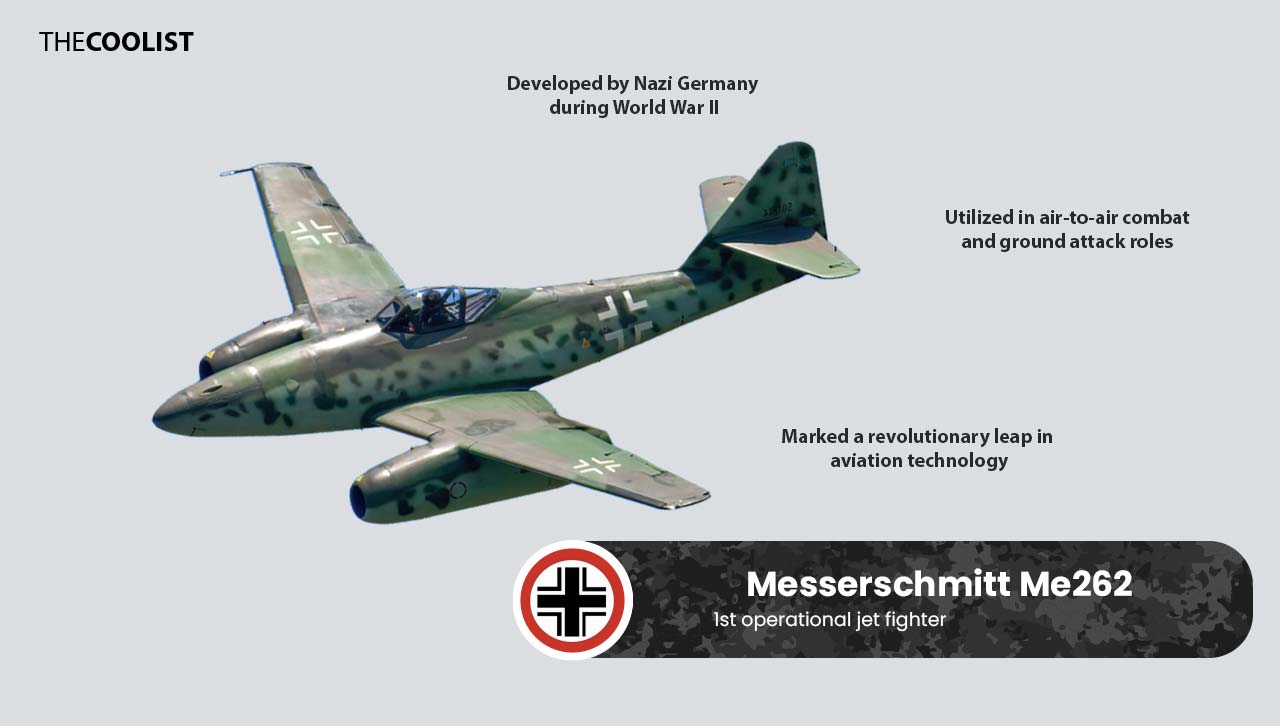
However, the Me 262 primarily served as an interceptor after finally entering service and countered the Allied bomber fleets that targeted German cities and infrastructure. The jet reached top speeds of up to 540 mph (870 km/h), surpassing any other combat aircraft of its era. The Me 262 carried four 30mm MK 108 cannons and 24 R4M air-to-air rockets. This powerful armament, combined with its speed, made the Me 262 a formidable opponent. The aircraft’s design allowed adaptation for various roles, including fighter-bomber and reconnaissance tasks.
Production challenges limited the Me 262’s influence on World War II’s outcome. Only about 1,400 Me 262s were built, and fewer than 300 participated in actual combat. However, the Me 262 marked a turning point in aerial warfare. It heralded the jet age and made piston-engine fighters nearly obsolete. Future generations of aircraft drew inspiration from the Me 262, thus securing its place as a pioneering marvel in aviation history.
What are the components of a jet fighter?
Below are the 11 components of a jet fighter.
- Airframe: The airframe is the physical skeleton of the aircraft that encompasses the fuselage, wings, and tail. The airframe of a jet fighter provides structural integrity and shape, ensuring that the aircraft can handle aerodynamic forces, stresses from payload, and high-G maneuvers. Elite fighters’ airframe design grants agility and speed while concealing the aircraft from radars.
- Cockpit: The cockpit is the fighter pilot’s operational hub inside the aircraft. The cockpit provides a sheltered space for the pilot and houses controls, displays, and avionics interfaces. Advanced digital interfaces present critical real-time data, including navigation and threat detection, ensuring pilots have comprehensive situational awareness and control.
- Engines: Jet engines are turbojet or turbofan mechanisms that generate thrust and thus give the aircraft its means of propulsion. Fighter jets’ engines produce thrust by ingesting air, mixing it with fuel, igniting the mixture, and expelling it at high speeds. Top-tier fighters’ engines enable the aircraft to change directions rapidly, accelerate quickly, and maintain sustained high speeds.
- Landing gear: The landing gear of a fighter jet is a system comprising wheels, struts, and brakes. The landing gear supports the aircraft on the ground and facilitates safe takeoffs and landings. Elite fighters’ landing gear is designed to absorb high-impact landings, quickly retract to reduce drag, and remain durable across various terrains.
- Avionics: Avionics are the electronic systems onboard the jet fighter. Avionics facilitate communication, navigation, targeting, and other vital functions during air combat operations. Advanced avionic systems in leading jets integrate vast amounts of data from sensors, radars, and external sources, ensuring precise targeting, threat assessment, and navigation.
- Weapons systems: Weapons systems comprise the aircraft’s offensive capabilities, which may include missiles, bombs, guns, and the systems to target and deploy them. Weapons systems provide the jet’s primary means of engaging adversaries. Advanced systems in the best fighter jets offer versatility in armament and allow pilots to address air-to-air, air-to-ground, and even maritime threats with precision.
- Fuel system: The fuel system comprises mechanisms for storing, managing, and delivering fuel to the engines. An efficient fuel system in top fighters ensures optimized fuel consumption and thus enables extended operational ranges and longer times on station.
- Flight control surfaces: Flight control surfaces include components that adjust the aircraft’s orientation, such as ailerons, rudders, and elevators. These components give the pilot control over the jet’s pitch, roll, and yaw movements. Cutting-edge fighters feature flight control surfaces that offer rapid response and enable intricate aerial maneuvers to evade threats or engage adversaries.
- Ejection seat: The ejection seat is a safety mechanism designed to rapidly propel the pilot out of the aircraft during emergencies. Modern ejection seats ensure the pilot’s safety post-ejection by incorporating parachutes and survival gear.
- Radar and sensors: Radars and sensors are systems that detect, track, and analyze targets or threats. These components provide the jet fighter pilot with a real-time view of the aerial battlefield, allowing them to make informed decisions on targeting, evasion, or engagement strategies.
- Electronic warfare systems: Electronic warfare systems comprise components that detect and disrupt enemy electronic emissions. These systems protect the aircraft from threats like guided missiles and enemy radar, ensuring that the fighter can operate safely in hostile electronic environments.
What are the fundamental features of a jet fighter?
Below are the three fundamental features of a jet fighter.
- Advanced avionics systems: At the heart of every modern fighter jet lies a sophisticated avionics suite, which integrates sensors, radars, communication systems, and electronic warfare capabilities. These systems provide pilots with comprehensive situational awareness, allowing them to receive real-time data on enemy positions, detect threats from great distances, and make informed decisions rapidly. Advanced avionics streamline the vast amount of information available, presenting only the most pertinent details to the pilot. This function ensures that the pilot remains well-informed without being overwhelmed amidst the chaos of aerial combat. Advanced avionic suites enable fighter jets to operate in highly contested environments, granting them a critical advantage with superior information dominance.
- Stealth capabilities: Stealth technology is an essential feature that drastically reduces an aircraft’s visibility to enemy radar and infrared sensors. Stealth is achieved through a combination of specialized materials that absorb or scatter radar waves, and meticulously designed airframe shapes that deflect radar signals away from their source. Minimizing the jet’s radar cross-section (RCS) and infrared (IR) signature allows the aircraft to operate closer to or even within enemy lines without being detected or targeted. Stealth capability is crucial for gaining the upper hand in aerial combat scenarios, as it allows the fighter jet to strike before the adversary is even aware of its presence.
- High-thrust, efficient engines: The engine is the powerhouse of a fighter jet, and is responsible for propelling it through the skies. Modern fighter engines are capable of producing immense thrust that allows rapid acceleration and the ability to maintain high speeds. Modern jet engines additionally provide the agility required to outmaneuver adversaries in dogfights. Today’s jet engines are designed for efficiency and ensure longer operational ranges and extended time in combat zones. A potent and efficient engine is a fundamental fighter jet feature as it determines the aircraft’s overall performance, from its top speed to its climbing rate. Split-second decisions mean the difference between victory and defeat in aerial combat, so having a superior engine grants pilots the advantage needed to prevail.
What are the future engineering designs for jet fighters?
Listed below are seven future engineering designs for jet fighters, along with their countries of origin, intended roles, costs, and any other publicly known project data.
- Tempest (UK): The Tempest project is a British-led initiative, with collaboration from Italy and Sweden. The Tempest aims to usher in a sixth-generation fighter to complement and eventually succeed the Eurofighter Typhoon in the Royal Air Force. Design goals for the Tempest focus on optional manning, artificial intelligence, directed energy weapons, and advanced stealth capabilities. Financial projections estimate an expenditure of around £2 billion for the initial developmental phase of The Tempest.
- FCAS/SCAF (France, Germany, Spain): France, Germany, and Spain collaborate on the FCAS (Future Combat Air System) or SCAF (Système de Combat Aérien Futur). The FCAS/SCAF project envisions a sixth-generation air system that integrates a next-generation fighter jet, drones, and a cohesive networked command structure. The fighter design prioritizes deep platform interoperability, advanced stealth properties, and the potential for unmanned operations. Total costs for the FCAS/SCAF endeavor are expected to approach €100 billion.
- F/A-XX (USA): The U.S. Navy spearheads the F/A-XX program, which seeks a successor to the F/A-18E/F Super Hornet and EA-18G Growler by the 2030s. Many specifics remain classified, but the expectations revolve around enhanced stealth, superior electronic warfare suites, and the possibility of unmanned functionality. The exact financial outlay for the F/A-XX project remains undisclosed.
- MiG LMFS (Russia): The Russian aircraft corporation MiG is developing the MiG LMFS as a light multi-role fifth-generation fighter. Advanced stealth capabilities, a high thrust-to-weight ratio, and state-of-the-art avionics are central to the design vision for this aircraft. The financial details of this endeavor are undisclosed.
- KAI KF-X/IF-X (South Korea, Indonesia): Korea Aerospace Industries leads the KAI KF-X/IF-X project in partnership with Indonesia. This initiative aims to produce a multi-role fighter to phase out aging aircraft models like the F-4 Phantom and F-5 Tiger. Key design attributes include cutting-edge avionics, stealth traits, and a versatile weapons suite. Developmental costs for the KAI KF-X/IF-X joint venture hover around $8 billion.
- HAL AMCA (India): Hindustan Aeronautics Limited (HAL) and the Aeronautical Development Agency (ADA) of India champion the HAL AMCA project. This fifth-generation multi-role stealth fighter emphasizes design elements like stealth, supercruise capabilities, and advanced avionic systems. The project’s budget stands at an approximate $5 billion.
- TF-X (Turkey): Turkish Aerospace Industries (TAI) drives the TF-X project with aspirations to introduce a fifth-generation air superiority fighter to succeed the F-16s in the Turkish Air Force. The aircraft design centers on stealth, sophisticated radar, sensor capacities, and enhanced maneuverability. The project’s financial blueprint outlines an estimated cost of around $13 billion.
What is the heaviest jet fighter?
The heaviest jet fighter is the American air superiority aircraft F-22 Raptor, with an empty weight of 43,340 lb (19,700 kg) and a Maximum Takeoff Weight (MTOW) of 83,500 lbs (38,000 kg). For comparison, the next-heaviest fighter jet is the F-15E Strike Eagle, a dual-role fighter designed for air-to-air and air-to-ground missions. The Strike Eagle’s empty weight is 31,700 lb (14,379 kg), while its MTOW is approximately 81,000 lbs (36,700 kg).
What is the fastest jet fighter?
The fastest jet fighter ever produced is the American high-altitude interceptor, Lockheed YF-12A. The YF-12A had a top speed of 1,800 knots (2,070 mph or 3,331 km/h), which is almost 3 times the speed of sound. However, the YF-12 never entered service with the US Air Force, despite being used as a research aircraft by both USAF and NASA. The fastest fighter jet that’s currently in service is the Soviet MiG-31, with a top speed of 1,600 knots (1,900 mph or 3,000 km/h), which is approximately 2.5 times faster than the speed of sound. The MiG-31 entered service with the Soviet Air Force in 1981 and remains in service with the Russian and Kazakh Air Forces.
Newer jet fighters, especially fifth-generation ones like the F-22 Raptor and the F-35 Lightning II, are capable of reaching speeds of around Mach 2 or slightly above. However, these modern fighter jets are not optimized for pure speed in the same way that older interceptors like the MiG-31 were. Instead, these modern aircraft prioritize stealth, advanced avionics, and multirole capabilities. Raw speed is less critical in modern air combat than it was in past eras. Today, factors such as stealth, sensor fusion, electronic warfare capabilities, and networked warfare play a more dominant role in determining a fighter jet’s effectiveness.
What is the most destructive jet fighter?
What the most destructive jet fighter is depends on how “destructiveness” is defined. However, defining the “destructiveness” of a fighter jet as its air-to-ground capability, air-to-air combat prowess, strategic impact, and versatility in various combat scenarios allows us to arrive at the three most destructive fighter jets below.
- Lockheed Martin F-35 Lightning II: The F-35 is exceptional in air-to-ground capabilities, equipped with advanced targeting systems and a broad array of munitions, features that make it lethal in ground attack roles. The F-35 is capable in air-to-air combat, though it wasn’t primarily designed as an air superiority fighter like the F-22. The F-35’s strengths lie more in its stealth, advanced sensor package, and networked operations. The strategic impact of the F-35 is significant, owing to its stealth capabilities, sensor fusion, and aptitude for network-centric warfare, all of which allow the jet to gather and share information swiftly and efficiently. This fighter is designed to excel in multiple roles, including combat, electronic warfare, and intelligence, surveillance, and reconnaissance (ISR).
- Lockheed Martin F-22 Raptor: The F-22 Raptor is a highly destructive air superiority fighter. The Raptor’s air-to-air combat capabilities are unmatched, largely due to its stealth technology, agility, and advanced avionics, which make it a formidable adversary in dogfights and beyond-visual-range engagements. The strategic impact of the F-22 is considerable in establishing air superiority early in a conflict. The F-22 additionally serves as a force multiplier due to its ability to operate in contested environments where other aircraft might be vulnerable. The F-22 likewise has capabilities in ground attack and electronic warfare, and is thus useful in various combat scenarios.
- Boeing F-15 E Strike Eagle: The F-15 E Strike Eagle is renowned for its air-to-ground capabilities as it’s able to deliver a wide range of destructive weapons effectively. The F-15 E remains very effective in air-to-air combat, though it lacks the stealth and some of the advanced technologies of fifth-generation fighters. The F-15 E’s strategic impact has been proven in numerous conflicts, excelling in strike missions and maintaining air superiority. The versatility of the F-15E is a key attribute of its deadliness, with its ability to perform strongly in both air-to-air and air-to-ground roles.
What are the historical air battles?
Below are the ten historical air battles that saw significant use of jet fighters, from the end of World War II to the late 20th century.
- Kargil War (1999): Indian Air Force jet fighters, including MiG-21s, MiG-27s, and Mirage 2000s, were used for the first time in high-altitude air combat over the rugged terrain of the Himalayas in this conflict between India and Pakistan. The operations (named “Operation Safed Sagar”) provided air support to Indian ground forces and attacked Pakistani positions. The conflict demonstrated the challenges and importance of air power in mountainous regions.
- Operation Desert Storm (1991): This conflict involved the U.S. and coalition forces facing Iraq and featured one of the largest deployments of jet fighters in history. Key jet fighters included the F-15, F-16, F/A-18, and A-10 on the coalition side, against Iraqi MiG-29s, Mirage F1s, and others. The operation’s objective was to liberate Kuwait from Iraqi occupation. The coalition achieved air superiority quickly and used it to conduct a successful ground campaign.
- Falklands War (1982): The British Royal Air Force and Fleet Air Arm used Harrier GR3s and Sea Harriers to fight against the Argentine Air Force and Navy, which operated Mirage III fighters, A-4 Skyhawks, and others. The Harriers effectively defended the British fleet and contributed to achieving air superiority despite being numerically inferior and operating far from home. The Falklands War underscored the effectiveness of Vertical and/or Short Take-off and Landing (V/STOL) aircraft and the importance of air power in naval battles.
- Operation Mole Cricket 19 (1982): Operation Mole Cricket 19 was a large-scale air battle between Israel and Syria during the 1982 Lebanon War. The air battle was notable for being the first time a Western-equipped air force successfully destroyed a Soviet-built surface-to-air missile (SAM) network. Israeli F-15s and F-16s played a crucial role in the skirmish, leveraging advanced electronic warfare tactics. The battle resulted in a significant loss of Syrian aircraft and SAM sites, thus demonstrating the effectiveness of modern air tactics and technology against Soviet air defense systems.
- Yom Kippur War (1973): The Yom Kippur War saw air battles between Israel and a coalition of Arab states, primarily Egypt and Syria. Jet fighters like the Israeli Mirage III and F-4 Phantom II faced off against Egyptian and Syrian MiG-21s and MiG-17s. The extensive use of SAMs by Egypt and Syria initially inflicted heavy losses on the Israeli Air Force. However, Israel eventually adapted its tactics, regaining air superiority. This conflict highlighted the growing importance of surface-to-air missile systems in aerial warfare and the need for effective countermeasures against them.
- Indo-Pakistani War of 1971: The Indo-Pakistani War involved air battles between the Indian Air Force and the Pakistani Air Force. Indian aircraft included MiG-21s, Su-7s, and Hawker Hunters, while Pakistan used F-86 Sabres and F-104 Starfighters among others. The objective was air superiority and supporting ground operations. India’s effective use of its air force contributed significantly to its victory, leading to the creation of Bangladesh.
- Six-Day War Air Battles (1967): The Six-Day War between Israel and its Arab neighbors (Egypt, Syria, Jordan, and Iraq), saw the Israeli Air Force execute a preemptive strike (Operation Focus) using a mix of French and American-built aircraft, including the Mirage III and the A-4 Skyhawk. Operation Focus targeted Egyptian airfields and aircraft and achieved overwhelming success by affording Israel air superiority early in the conflict.
- Operation Bolo (1967): Operation Bolo was an air battle that occurred during the Vietnam War, near Hanoi. USAF pilot Colonel Robin Olds devised the operation as a ruse to draw out North Vietnamese MiG-21s by mimicking the flight profile of slower F-105 Thunderchiefs. In reality, the U.S. fighters were the more capable F-4 Phantom IIs. The strategy succeeded, destroying several Vietnamese MiG-21s without any U.S. losses.
- Battle of MiG Alley (1950–1953): This series of air engagements took place in the skies over northwestern North Korea during the Korean War. This region was dubbed “MiG Alley” due to the prevalence of Soviet-built MiG-15 jet fighters. The area saw intense dogfights between UN forces using F-86 Sabres, and North Korean and Chinese forces, equipped with MiG-15s, as the dueling sides fought for air superiority. The U.S. claimed a favorable kill ratio, but both sides suffered losses. The battles emphasized the importance of jet-powered air combat and led to significant developments in air combat tactics and training.
- V-1 Raids over Britain (1944): The early jet-powered Gloster Meteors of the Royal Air Force defended the United Kingdom against the German V-1 attacks. The Meteors were used sparingly and did not see combat in the broader conflict apart from intercepting the V-1 flying bombs. However, the Meteors’ use represented an early foray into jet-powered air combat.
Who are the most famous fighter jet pilots?
Below is a list of 15 famous fighter jet pilots who have earned their recognition as aces or have contributed significantly to the advance of aerial combat.
- Adolf Galland (Germany): Adolf Galland was a World War II Luftwaffe general and flying ace who transitioned from propeller-driven aircraft to jets. Galland ended WWII flying the Messerschmitt Me 262, the world’s first operational jet-powered fighter. He was an advocate for fighter jets in the Luftwaffe.
- Clarence “Bud” Anderson (USA): Clarence “Bud” Anderson was a triple ace in World War II and later tested a variety of jet aircraft including the North American F-86 Sabre and the YF-100 Super Sabre. Anderson’s contributions to jet fighter testing and development were significant during the early years of the jet age.
- Chuck Yeager (USA): Chuck Yeager was a former USAF officer and record-setting test pilot, who became the first person to break the sound barrier in 1947, flying the Bell X-1. Yeager flew P-51 Mustangs in World War II and later served as a test pilot for a variety of jet aircraft.
- Gabby Gabreski (USA): Joseph F. Gabreski (known as “Gabby”) was a top American fighter ace in Europe during World War II and a jet fighter ace in the Korean War. He achieved a combined total of 34.5 victories in both wars flying P-47 Thunderbolts and F-86 Sabres.
- Robin Olds (USA): Robin Olds was an American fighter pilot and brigadier general in the USAF. Olds was an ace with a combined total of 17 victories in World War II and the Vietnam War. He flew P-51 Mustangs and P-38 Lightnings in WWII and the F-4 Phantom II in Vietnam.
- Steve Ritchie (USA): Steve Ritchie was an American fighter pilot and Captain in the USAF, recognized as the first U.S. Air Force pilot ace of the Vietnam War. Ritchie achieved a total of five confirmed air-to-air victories, all of which were achieved flying the F-4 Phantom II. His prowess and tactical skills played a significant role in air combat during the conflict.
- Charles B. DeBellevue (USA): Capt. Charles B. DeBellevue is a renowned American fighter weapon systems officer in the USAF. He became the leading U.S. ace of the Vietnam War, credited with six air-to-air victories, all while serving in the F-4 Phantom II. Captain DeBellevue’s combat achievements made him the most successful American ace of the Vietnam era.
- Jeffrey Feinstein (USA): Jeffrey Feinstein was a notable American fighter pilot in the USAF during the Vietnam War. He attained ace status with five confirmed air-to-air victories, distinguishing himself in the challenging aerial combat environment of the conflict. Captain Feinstein primarily flew the F-4 Phantom II.
- Randy “Duke” Cunningham (USA): Randy “Duke” Cunningham was a U.S. Navy fighter pilot during the Vietnam War. Cunningham is credited with five aerial victories, making him one of the few American aces of that war. He mainly flew the F-4 Phantom II, engaging in notable dogfights against North Vietnamese MiGs.
- Giora Epstein (Israel): Giora Epstein is known as the “Ace of Aces” of the Israeli Air Force. Epstein is credited with 17 victories, the highest of any Israeli pilot. He achieved most of his kills flying the Mirage III and the Nesher during conflicts such as the Yom Kippur War.
- Cesar Rodriguez (USA): Cesar Rodriguez is a retired USAF Lieutenant Colonel and one of the most recent American fighter aces. Rodriguez is known for his expertise in the F-15 Eagle, in which he achieved three air-to-air kills during operations over Iraq and the Balkans. The pilot’s combat record makes him one of the few American aces since the Vietnam War.
- Gregory “Beast” Feest (USA): Gregory Feest is a USAF pilot, who was the first to drop a bomb during Operation Desert Storm in 1991 from an F-117 Nighthawk. Feest’s actions marked the combat debut of the F-117 in attacking critical Iraqi radar and command centers and showcased the effectiveness of stealth technology in modern warfare.
- Talal Al Mansouri (United Arab Emirates): Squadron Leader Talal Al Mansouri was a UAE Air Force pilot who gained recognition for his role in the air campaign against ISIS in Syria. Al Mansouri flew the F-16 Fighting Falcon in missions that were crucial in the multinational effort to combat ISIS.
- Brian Shul (USA): Brian Shul is a retired U.S. Air Force Major and a former “Wild Weasel” pilot. Brian Shul was best known for flying the SR-71 Blackbird in reconnaissance missions. His daring missions at the edge of space over hostile territories during the Cold War and post-Vietnam conflicts are legendary.
- David Goldfein (USA): David Goldfein is a former Chief of Staff of the USAF and F-16 pilot who was shot down over Serbia during the 1999 NATO bombing campaign in Kosovo. Goldfein’s successful ejection, evasion, and eventual rescue highlighted the risks and resilience of modern jet fighter pilots in combat.
What are the fundamental differences between an airplane and a jet fighter?
There is one fundamental difference between an airplane and a jet fighter. An airplane is any craft that’s able to become airborne and travel through the Earth’s atmosphere thanks to chemical or mechanical propulsion. Meanwhile, a fighter jet is a type of airplane that’s designed specifically for air-to-air (and often air-to-ground) combat. All fighter jets are airplanes, while not all airplanes are fighter jets, and there are many other military and civilian airplane types. The list below explains the differences between fighter jets and various other types of military airplanes.
- Fighter jet vs. transport airplane: Fighter jets are designed for air-to-air combat and ground attacks, while transport airplanes are built for logistical support. Fighters are smaller, faster, and more agile, equipped with weapons and optimized for combat scenarios. In contrast, transport planes are larger, and designed to carry troops, equipment, and supplies. To this end, transport planes feature spacious cargo holds and prioritize range and capacity over speed and maneuverability.
- Fighter jet vs. bomber airplane: Fighter jets focus on air superiority and tactical missions, whereas bombers are designed for long-range, heavy ordnance delivery. Agile and fast fighters excel in combat scenarios, often incorporating stealth technology. Bombers are larger and less agile, with design features emphasizing payload capacity and range to strike distant targets.
- Fighter jet vs. reconnaissance airplane: Fighter jets are engineered for direct combat, while reconnaissance airplanes specialize in information gathering. Combat-oriented jets possess missiles and guns for air and ground engagements. Reconnaissance planes, however, prioritize surveillance equipment, endurance, and high-altitude capability, as they strive to avoid direct combat.
- Fighter jet vs. tanker airplane: Fighter jets are built for aerial combat requiring speed and agility, in contrast to tanker airplanes, which are designed for aerial refueling. While fighters are equipped for short, intense missions, tankers support extended operations, enabling other aircraft to function over longer distances through mid-air refueling.
- Fighter jet vs. electronic warfare airplane: Fighter jets are primarily used in combat engagements, unlike electronic warfare airplanes which focus on electronic attack and defense. Combat aircraft are agile and armed for air and ground battles. In contrast, electronic warfare planes carry specialized equipment for disrupting enemy electronics and radar, and function in a support role rather than direct combat.
Additionally, the list below explains how fighter jets stack up against civilian airplanes.
- Fighter jet vs. commercial airliner: Fighter jets are built for military combat, while commercial airliners are designed for carrying passengers over long distances. Military jets are maneuverable, fast, and equipped with weaponry and advanced targeting systems for extreme flight conditions. In contrast, commercial airliners focus on passenger safety, comfort, and fuel efficiency, and offer spacious cabins and long-range capabilities.
- Fighter jet vs private jet: Fighter jets are designed for combat and feature high speeds and advanced avionics, whereas private jets are tailored for luxury and business travel. Military aircraft offer maneuverability and combat capabilities, while private jets prioritize passenger comfort, cabin amenities, and long-range travel without combat features.
- Fighter jet vs light airplane: Fighter jets are high-performance military aircraft for combat, whereas light aircraft are used for personal or light transport. Fighter jets are able to reach supersonic speeds and come equipped with sophisticated weaponry, contrasting with light aircraft, which are slow, simple in design, and function largely in recreational, training, or light transport roles.
- Fighter jet vs cargo airplane: Fighter jets are optimized for air combat and precision strikes, while cargo airplanes focus on transporting goods. Agile and armed military jets are built for speed and air supremacy, in stark contrast to cargo airplanes, which prioritize large cargo holds, high payload capacities, and logistical efficiency over speed or combat readiness.
- Fighter jet vs agricultural aircraft: Fighter jets are advanced military aircraft designed for armed conflict, unlike agricultural aircraft which are used for farming tasks. Military jets are fast, armed, and operate at high altitudes, contrasting with agricultural planes, which are built for low-altitude, slow-speed operations in agriculture that focus on carrying capacities for chemicals or fertilizers instead of weaponry.
What are the best airplanes for civilian travel?
Below is a list of the 10 best airplanes for civilian travel.
- Airbus A350: The Airbus A350 is known for its fuel efficiency, range, and passenger comfort. The A350 has a modern design with a quiet cabin, advanced air conditioning technology, and larger windows. These features allow the aircraft to provide an enhanced passenger experience for long-haul flights.
- Boeing 787 Dreamliner: The Boeing 787 Dreamliner is celebrated for its innovative use of composite materials, fuel efficiency, and passenger comfort innovations such as improved cabin pressure and humidity levels. The Dreamliner’s efficiency and range make it a popular choice for airlines globally.
- Airbus A380: The Airbus A380 remains the world’s largest passenger airliner and is famed for its spaciousness, quiet cabin, and smooth flight characteristics. The double-decker is a favorite for long-haul flights and offers amenities like showers and bars in some configurations.
- Boeing 777: The Boeing 777 (and particularly in its newer 777X variant) is a mainstay of long-haul international travel. The widebody Boeing is known for its reliability, range, and capacity. The 777X features larger windows, a wider cabin, and improvements in efficiency and noise reduction.
- Airbus A320neo Family: The Airbus A320neo family (including the A319neo, A320neo, and A321neo) is a leader in the short- to medium-haul market. These aircraft are popular for their fuel efficiency, reduced noise footprint, and cabin comfort enhancements.
- Boeing 737 MAX: Boeing 737 MAX has overcome initial safety challenges and an abysmal reputation to become a staple medium-range airliner in many of the world’s top airlines. The MAX is known for its improved fuel efficiency and updated cabin designs that offer advanced technology and comfort.
- Embraer E-Jet E2 Series: Embraer’s E-Jet E2 series is highly regarded in the regional jet market. E-Jet E2 series aircraft are praised for their efficiency, low operational costs, and passenger comfort. The E2s feature a 2-2 seating arrangement that eliminates middle seats.
- Bombardier CRJ Series: The Bombardier CRJ series (particularly the newer CRJ900 and CRJ1000 variants) are key players in the regional jet segment. The CRJ series aircraft offer a balance of efficiency, range, and comfort for shorter routes. These airplanes are quite popular in North American and European markets.
- ATR 72-600: The ATR 72-600 is a turboprop aircraft that’s known for its fuel efficiency and suitability for short-haul, regional operations. The ATR 72-600 is a preferred choice for routes with lower passenger density and offers the double benefit of low operational costs and a comfortable cabin.
- Cessna Citation Longitude: The Cessna Citation Longitude is a private jet that deserves mention for its passenger comfort, range, and advanced avionics in the private jet sector. The Longitude is ideal for small groups looking for a high-quality, comfortable, and efficient travel experience.
Are civilian airplanes more comfortable than jet fighters?
Yes, civilian airplanes are more comfortable than jet fighters. Below are the 10 ways in which civilian planes incontestably surpass jet fighters in terms of comfort.
- Spacious cabins: Commercial and private civilian airplanes offer spacious cabins with room to walk around, stretch, and relax, unlike the cramped cockpit of a fighter jet which is designed only for the pilot and essential controls. For example, the Piaggio Aero P180 Avanti II, a private jet, features an exceptionally spacious cabin for its class, with an interior that offers top-tier passenger comfort.
- Cabin pressurization and air quality: Civilian aircraft feature advanced cabin pressurization and air quality systems, which maintain a comfortable cabin environment at high cruising altitudes. Fighter jets likewise have pressurization systems, but these are optimized for performance and pilot endurance rather than passenger comfort.
- Seating and amenities: Commercial aircraft provide passengers with adjustable individual seats along with amenities like in-flight entertainment, food services, and lavatories. Fighter jets lack these amenities, focusing solely on the pilot’s operational needs.
- Noise levels: Civilian airplanes, especially modern ones, are designed to minimize interior noise for a more pleasant travel experience. In contrast, fighter jets and their powerful engines produce significantly higher noise levels, which result in fatigue over long periods.
- Smooth flight experience: Commercial airplanes are designed to offer a smooth flying experience, such as technologies that reduce turbulence and provide in-flight stability. Fighter jets are optimized for agility and speed but subject pilots to sharp maneuvers and high G-forces, which are far from comfortable.
- Temperature control: Passenger planes are equipped with systems to maintain a stable and comfortable temperature inside the cabin. Meanwhile, fighter jets’ environmental control systems prioritize critical performance aspects over optimal temperature comfort.
- Accessibility and safety features: Commercial airplanes are designed with accessibility for a wide range of passengers, including children, the elderly, and those with reduced mobility. Airliners additionally include numerous safety features designed for passenger protection. On the other hand, fighter jets are built for highly trained pilots who are fit and acclimatized to the inhospitable environments associated with high altitudes and excessive G-forces. As such, fighter jets prioritize operational capabilities over accessibility and general passenger safety features.
- Baggage storage: Civilian airplanes have ample space for personal and checked baggage, thus allowing passengers to bring personal items on their travels. Fighter jets lack storage space, carrying only essential gear and mission-specific equipment.
What are the best airlines?
Below is a list of the five best airlines, according to the rankings assigned at the Skytrax 2023 World Airline Awards.
- Singapore Airlines: Singapore Airlines is renowned for its exceptional service quality, luxurious cabin comfort, and innovative in-flight entertainment and connectivity. The airline consistently receives accolades for its premium seating options, outstanding culinary offerings, and highly trained cabin crew. Its commitment to customer service and operational excellence makes it a favorite among international travelers.
- Qatar Airways: Qatar Airways stands out for its luxury, comfort, and service quality, especially in its business-class offerings. Known for its state-of-the-art fleet, including the Airbus A350 and Boeing 787, the airline offers one of the industry’s best in-flight experiences. Qatar Airways also boasts a superior level of hospitality, with attention to detail and a wide network that connects over 160 destinations worldwide.
- ANA All Nippon Airways: ANA All Nippon Airways is celebrated for its reliability, punctuality, high-quality service, and clean, well-maintained aircraft. The airline is notable for incorporating traditional Japanese hospitality, or “Omotenashi,” providing passengers with a unique and comfortable flying experience. It also often leads in technological innovations, eco-friendly practices, and offering a broad route network.
- Emirates: Emirates is known for its opulent service, particularly in first and business classes, offering amenities like onboard showers and private suites. Operating a fleet of large, modern aircraft such as the Airbus A380, the airline provides passengers with spacious seating, a generous entertainment selection, and gourmet dining. Emirates’ global network, connecting passengers to over 150 cities on six continents, adds to its appeal as a top global carrier.
- Japan Airlines: Japan Airlines (JAL) is highly regarded for its exceptional service, comfortable seating, and reliability. The airline focuses on providing an authentic Japanese experience, from in-flight meals to entertainment. JAL is also appreciated for its efforts in maintaining a punctual flight schedule and offering one of the industry’s best economy-class services, emphasizing passenger comfort and convenience.
The following six criteria typically inform airline rankings such as those produced by Slytrax above. Firstly, the best airlines are safe, with no fatal incidents, non-fatal accidents causing injuries, or near-misses with the potential to result in fatalities, injuries, or hull damage. Secondly, the best airline companies are punctual, generally having few delays and short average delay times. Thirdly, the best airlines provide spacious cabins with sufficient leg room for their passengers. Fourthly, the top airline companies offer a substantial assortment of meals and snacks and account for various dietary restrictions. Fifthly, the best airways in the world offer a large array of on-board entertainment. Finally, the world’s most acclaimed airlines offer superior customer service throughout a passenger’s journey, from purchasing tickets to retrieving their luggage upon arrival.
What are the photograph series of jet fighters?
Below is a list of photograph series of jet fighters and other jet airplanes.
- “Air Forces: The World’s Jet Fighters” by Peter R. March: Peter R. March’s collection showcases a wide array of modern jet fighters from air forces around the globe. The series features dynamic photographs and provides an up-close look at the technology and design of contemporary military aircraft.
- “Jet Airliner” by Josef Hoflehner: Hoflehner’s series is famous for its dramatic black-and-white images capturing the raw power and beauty of jet airliners. Hoflehner’s work is noted for its stark, minimalist compositions, which often feature aircraft in motion against serene backdrops, thus emphasizing the contrast between technology and nature.
- “Fighter Jets” by Martin Bowman: Bowman’s work is a tribute to the speed, agility, and might of fighter jets. His photography captures these aircraft in various settings, ranging from high-speed action shots during airshows to intimate portraits on the ground.
- “Speedbirds” by Ian Black: Black’s series focuses on jet fighters from different eras and includes both air-to-air and ground photography. Ian Black’s images often feature the grace and potency of fighter jets, and make a particular emphasis on capturing the essence of their speed and maneuverability.
- “Jets at Sea: Naval Aviation in Transition 1945–1955” by Leo Marriott: Marriott’s work is a visually arresting series that documents the early years of jet fighters aboard aircraft carriers. The images in Marriott’s collection provide insight into the development and challenges of operating jet aircraft in maritime environments.
- “The Art of the Airport: The World’s Most Beautiful Terminals” by Alexander Gutzmer: Gutzmer’s series includes a range of stunning airport architectures, providing a backdrop to the variety of aircraft, including military jets, that operate within these complex spaces.
The photography series and books above offer a fascinating glimpse into the world of jet fighters and aviation. The images in them illustrate both the technical aspects of these aircraft and the aesthetic beauty they possess.
